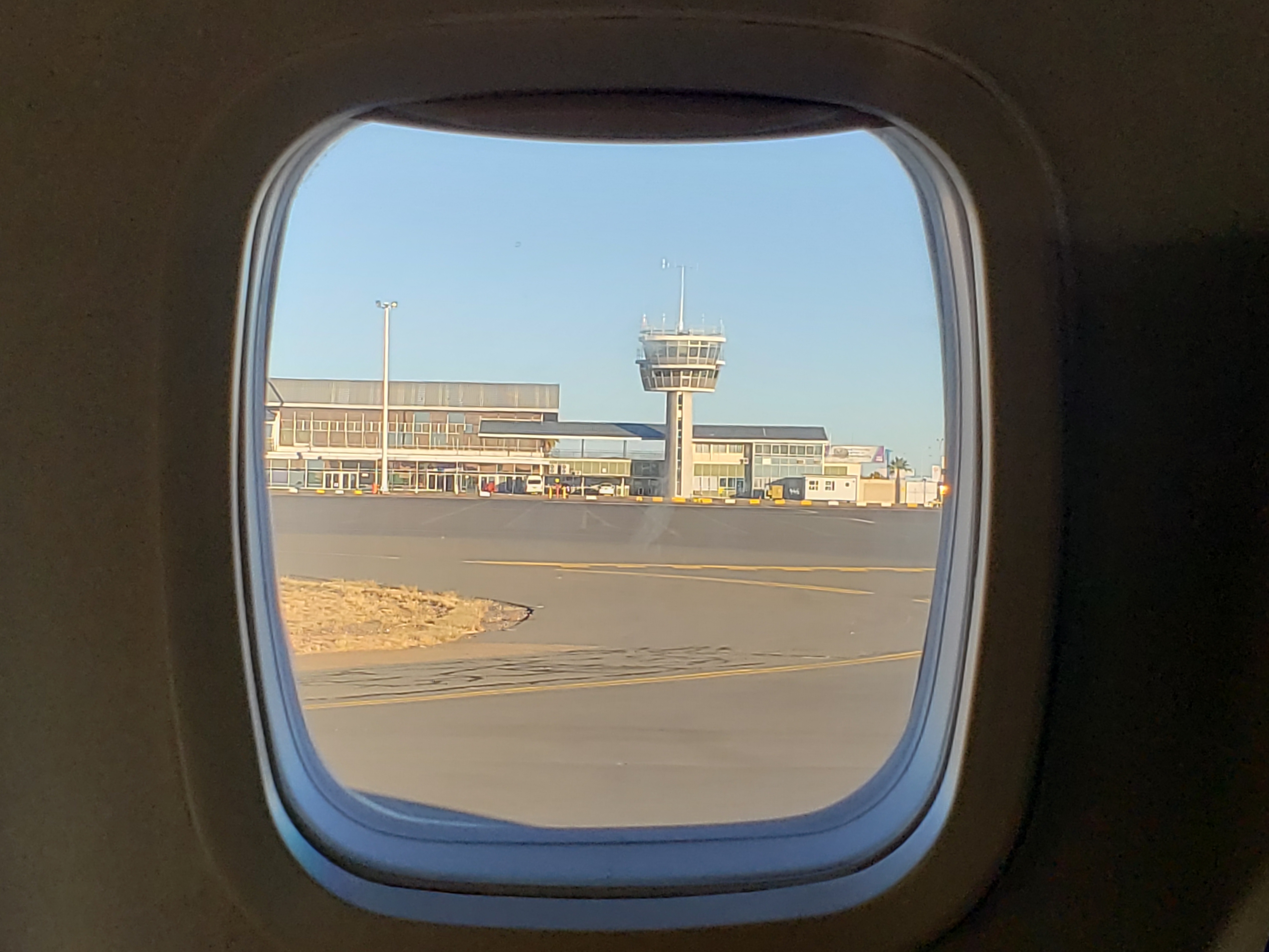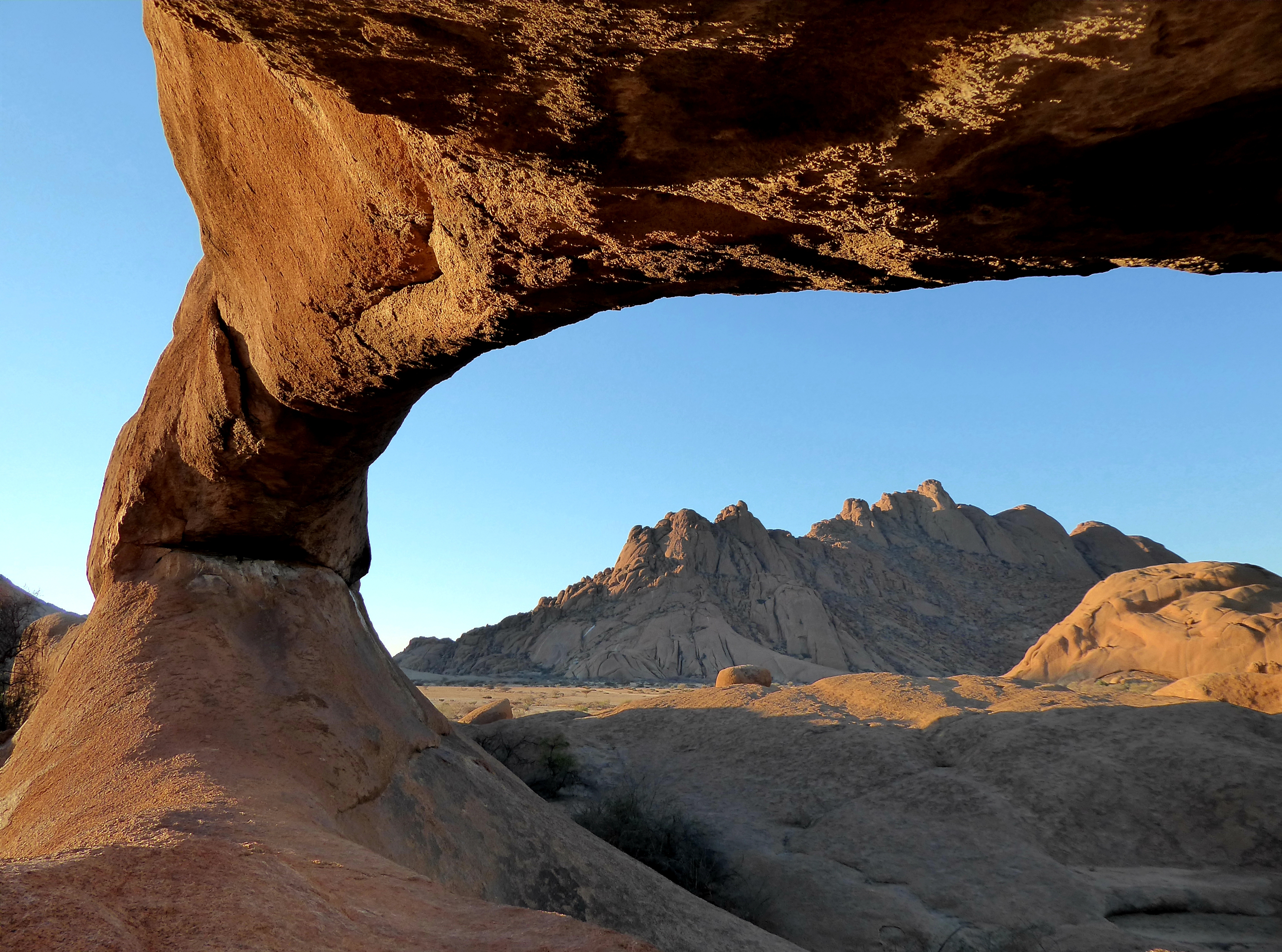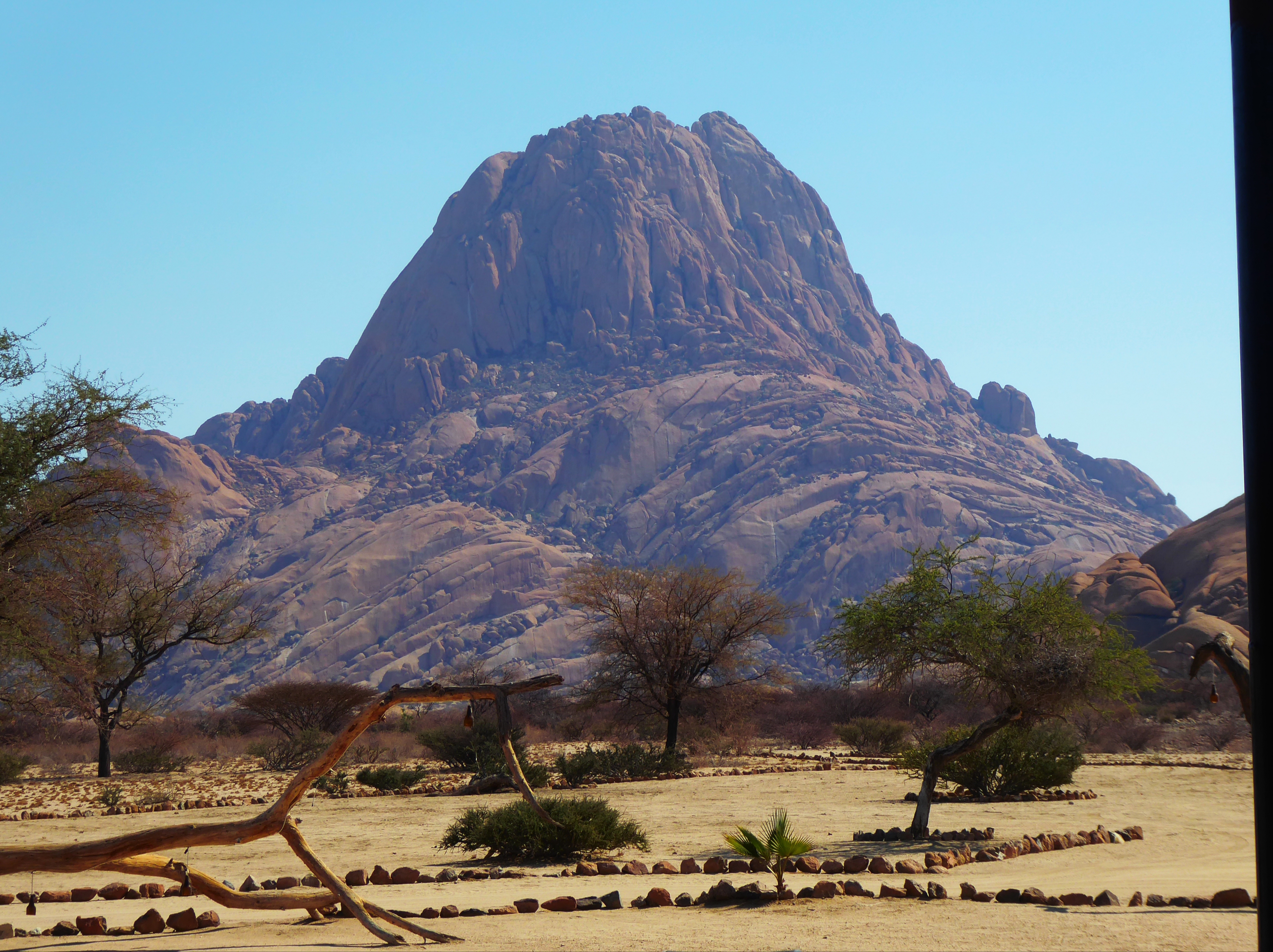IV. On the Road: Week Three (Swakopmund “Swako” to Epupa Falls)
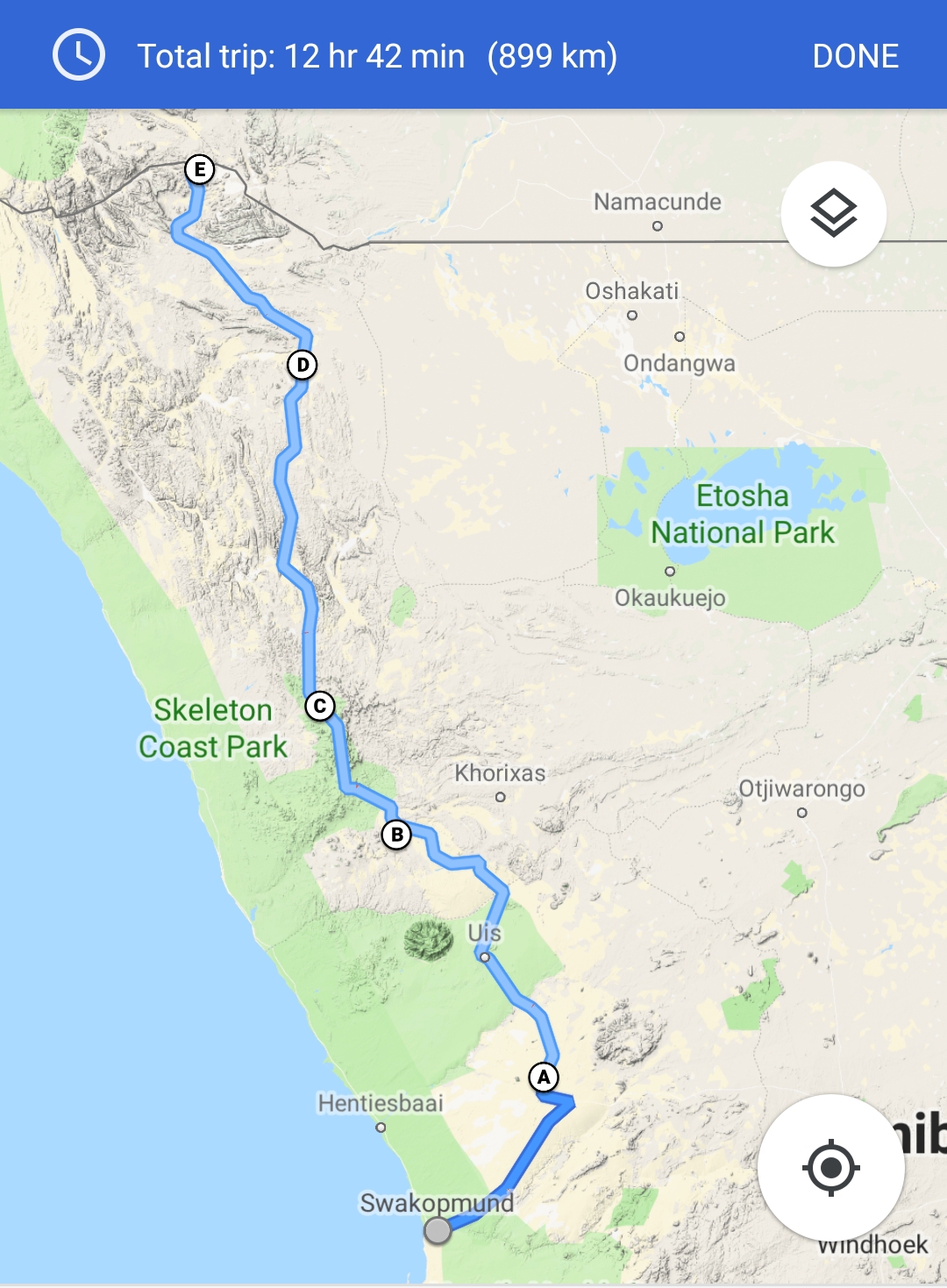 Swako, Spitzkoppe, Twyfelfontein, Palmwag, Opuwo, Epupa Falls
Swako, Spitzkoppe, Twyfelfontein, Palmwag, Opuwo, Epupa Falls
The day I left Swakopmund, the area experienced a major power outage due to high winds. I’d been told “The sandstorms here can strip the paint off your car.” Carol, the host of my apartment, advised me to wait out the morning until the winds subsided. I did. When I left town around noon, sand was blowing across the highway. I figured if need be, I’d turn back and stay in “Swako” another night. But the drive, despite the usual bad roads, went well.
******
Driving from the coast, the terrain changed dramatically. Mountains suddenly jutted out of the desert. I was nearing Spitzkoppe, a group of granite peaks.
I passed simple structures of wood decorated with cans and bones. Locals had set up stalls by the road to sell handmade souvenirs and minerals. I pulled into the Spitzkoppe Tented Camp and was greeted by a young woman: her brother was the owner and both had grown up in the village.
My accommodation, a large canvas tent with bedroom and en suite outdoor private bathroom, had a spectacular view of the mountains. I was grateful I’d brought my down sleeping bag from AfrikaBurn, nights and mornings were cold.
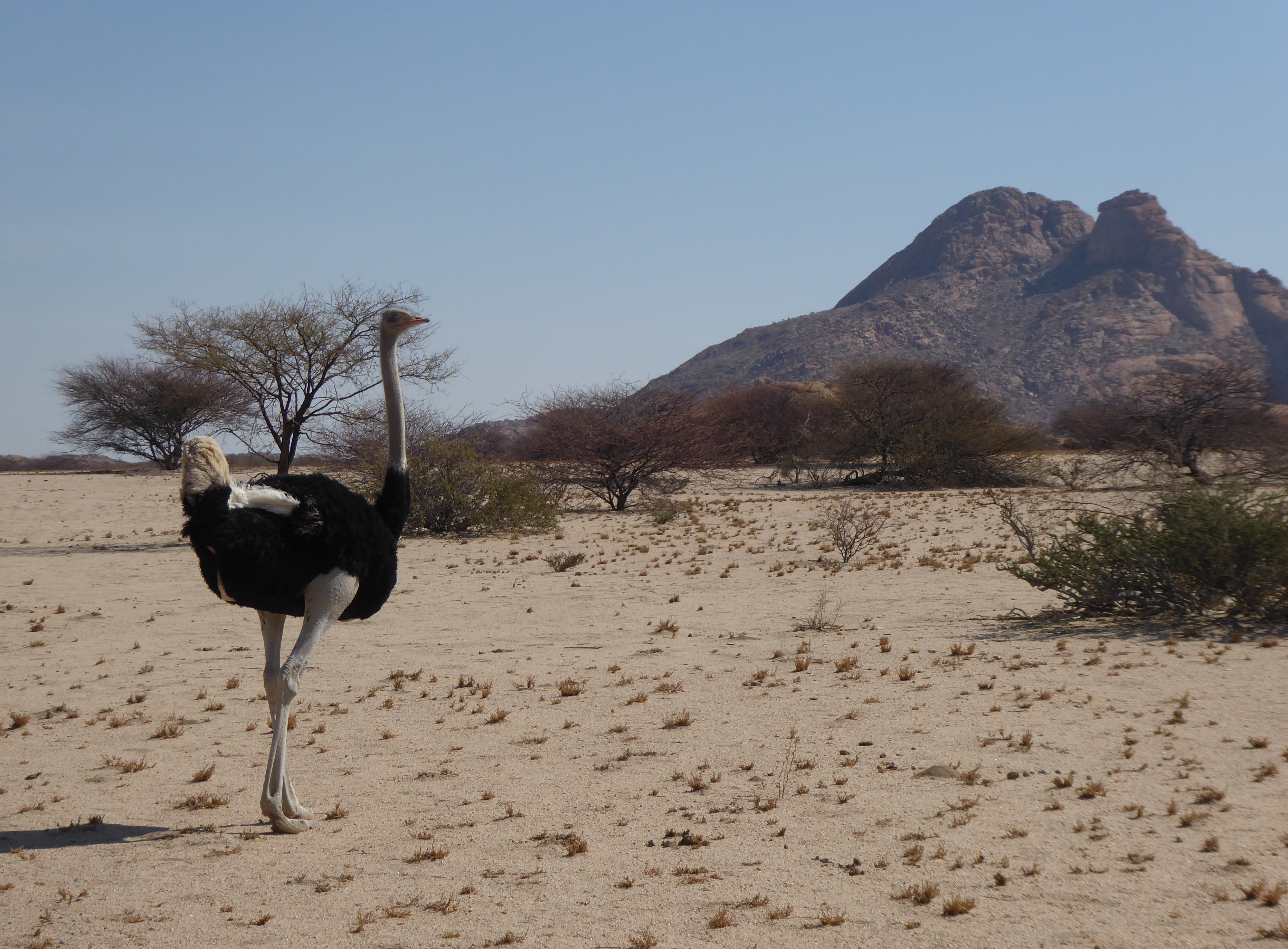
I spent the days walking through the beautiful landscape and meeting the residents of the village, about a fifteen minute walk away. At night I gazed at the sky enjoying the solitude, as if I were the only living creature for miles. The barking dogs, and the sudden loud music coming from the shebeens(bars) of the village, would abruptly disrupt the illusion.
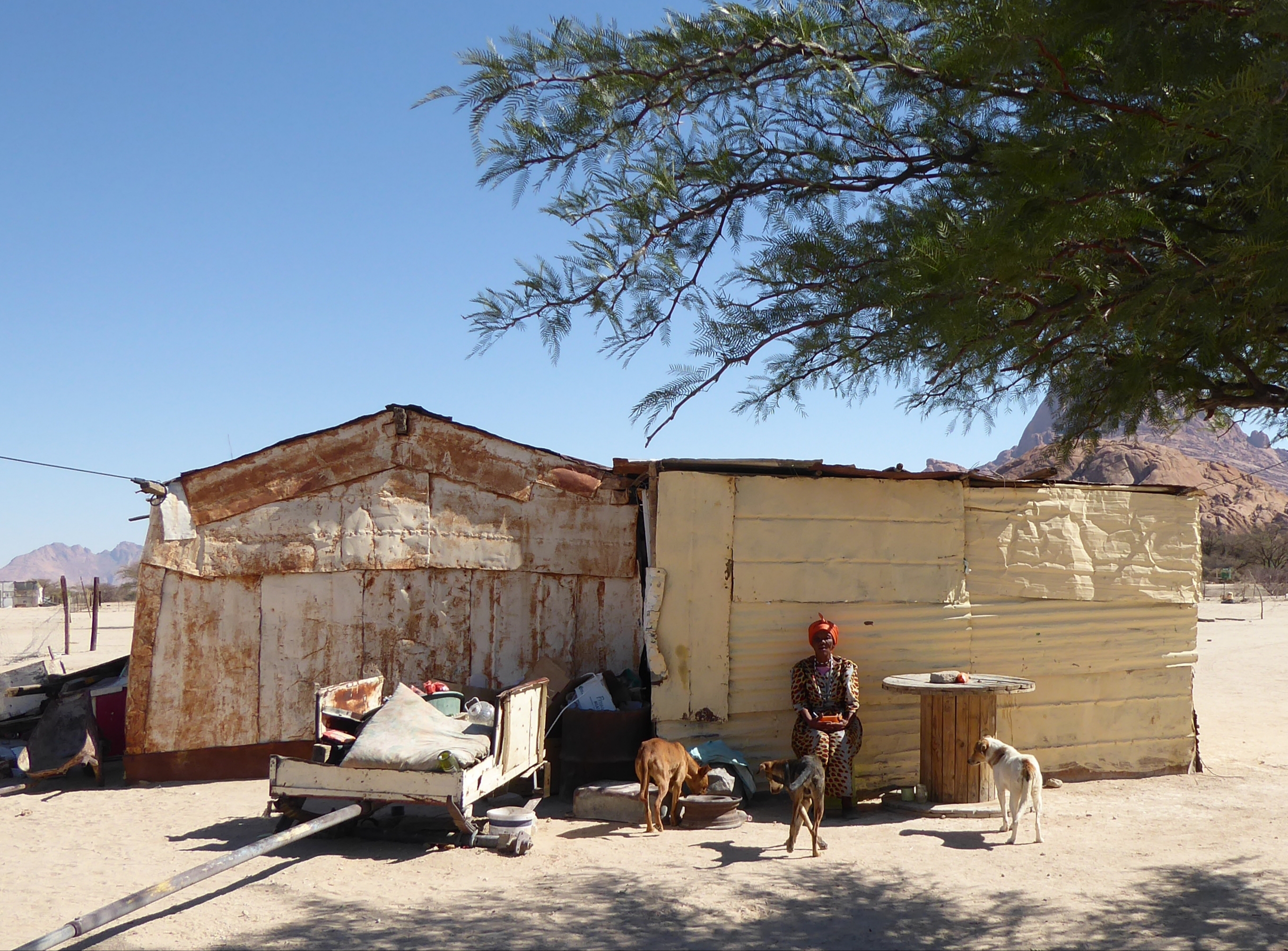
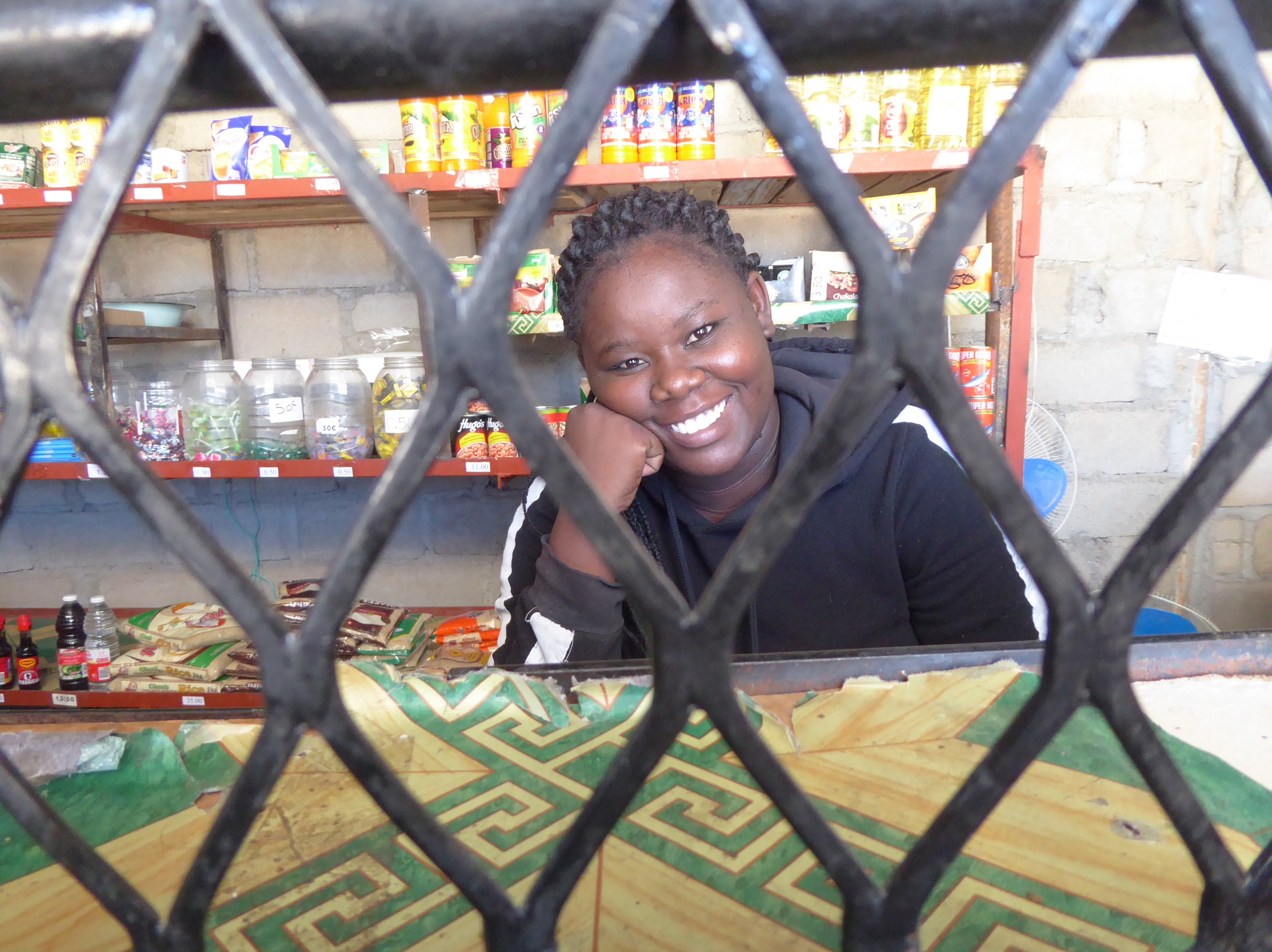
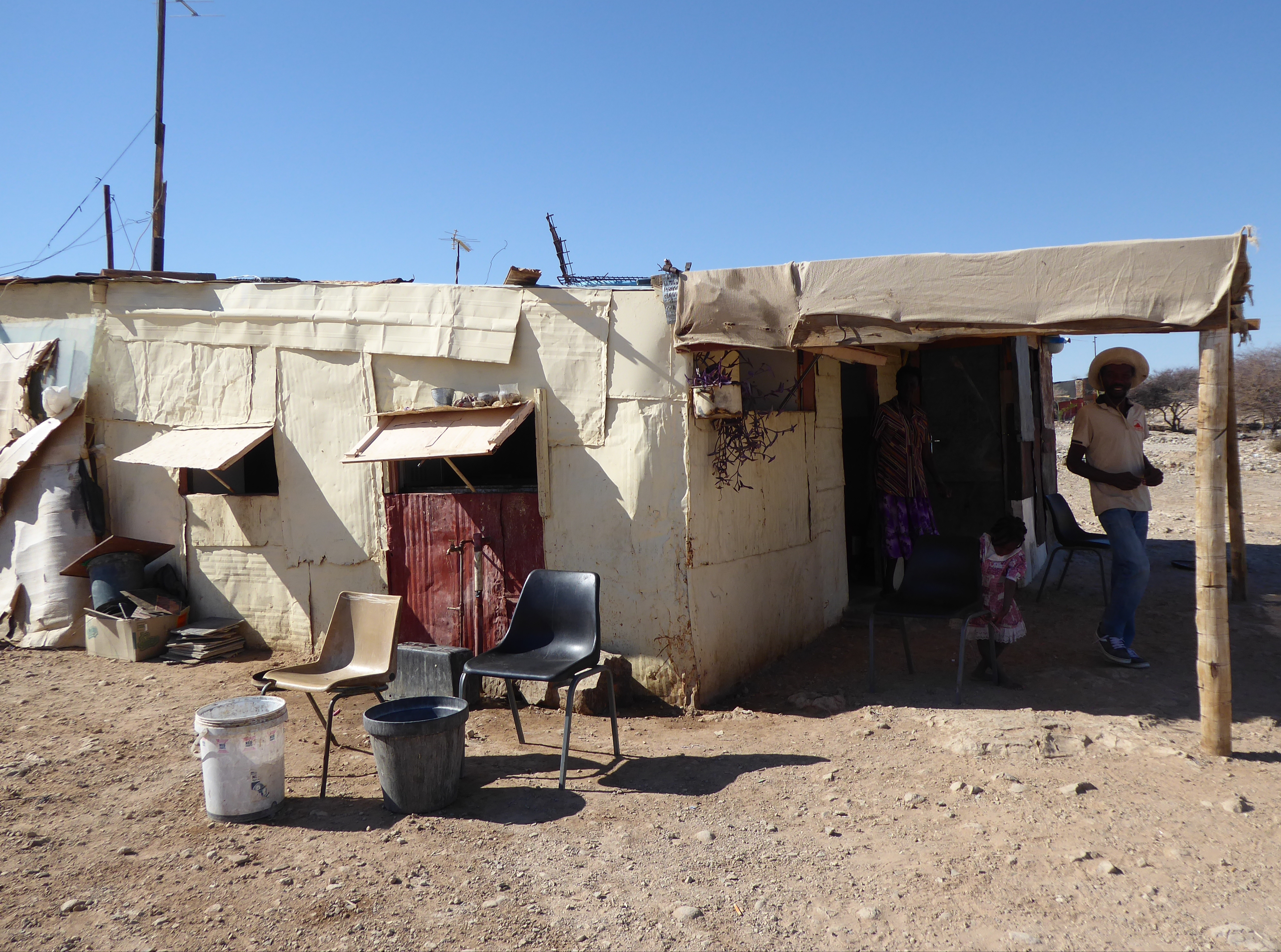
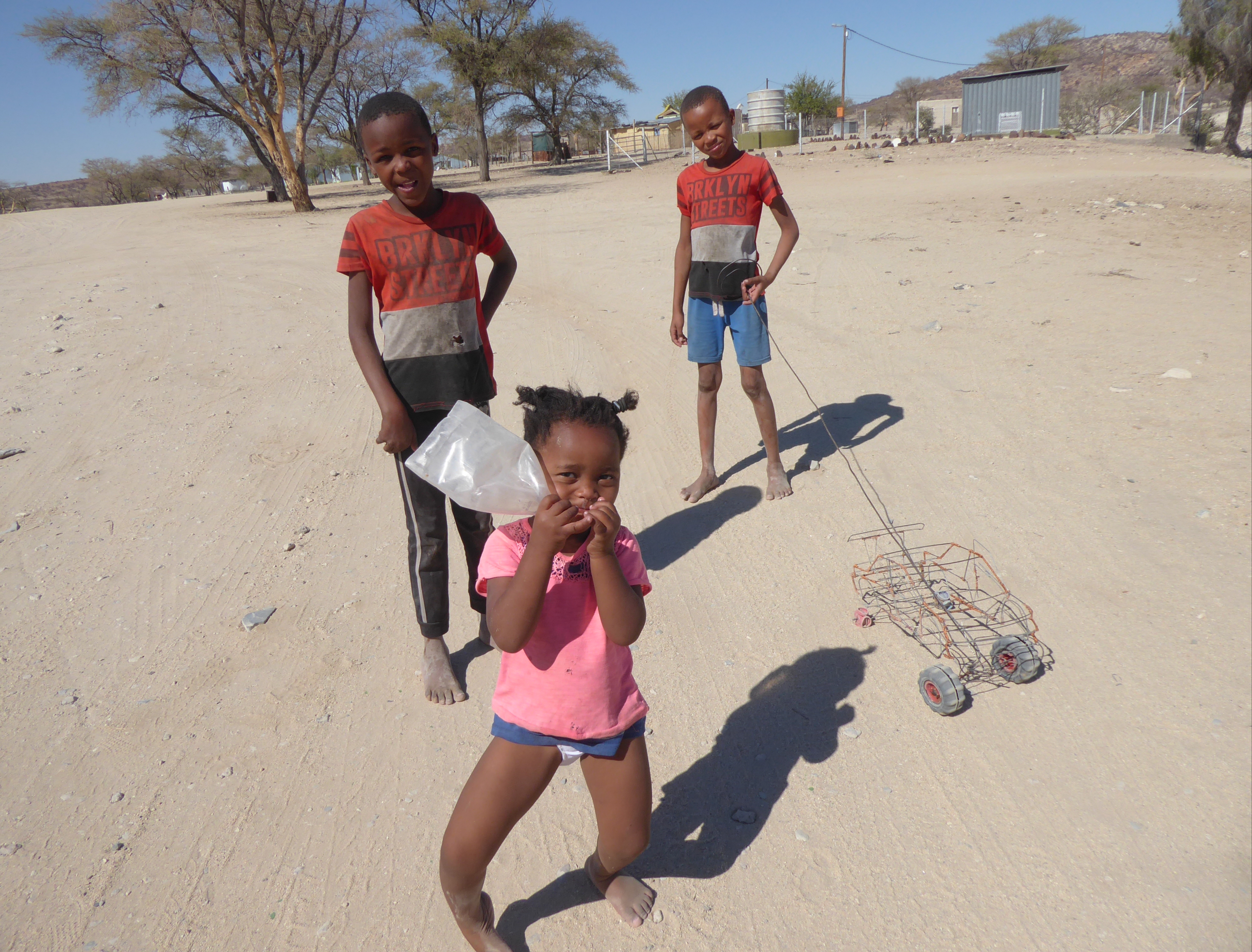
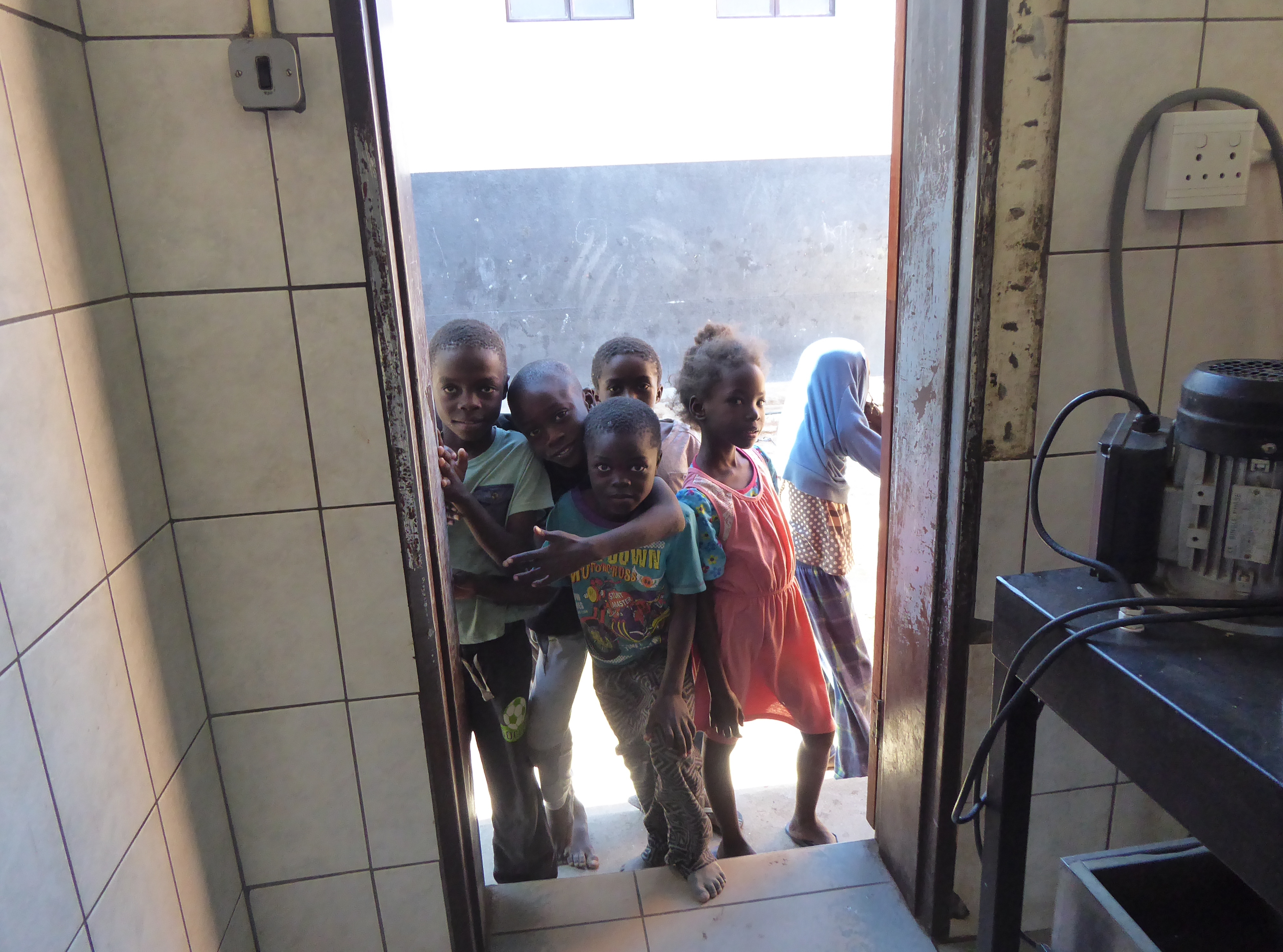
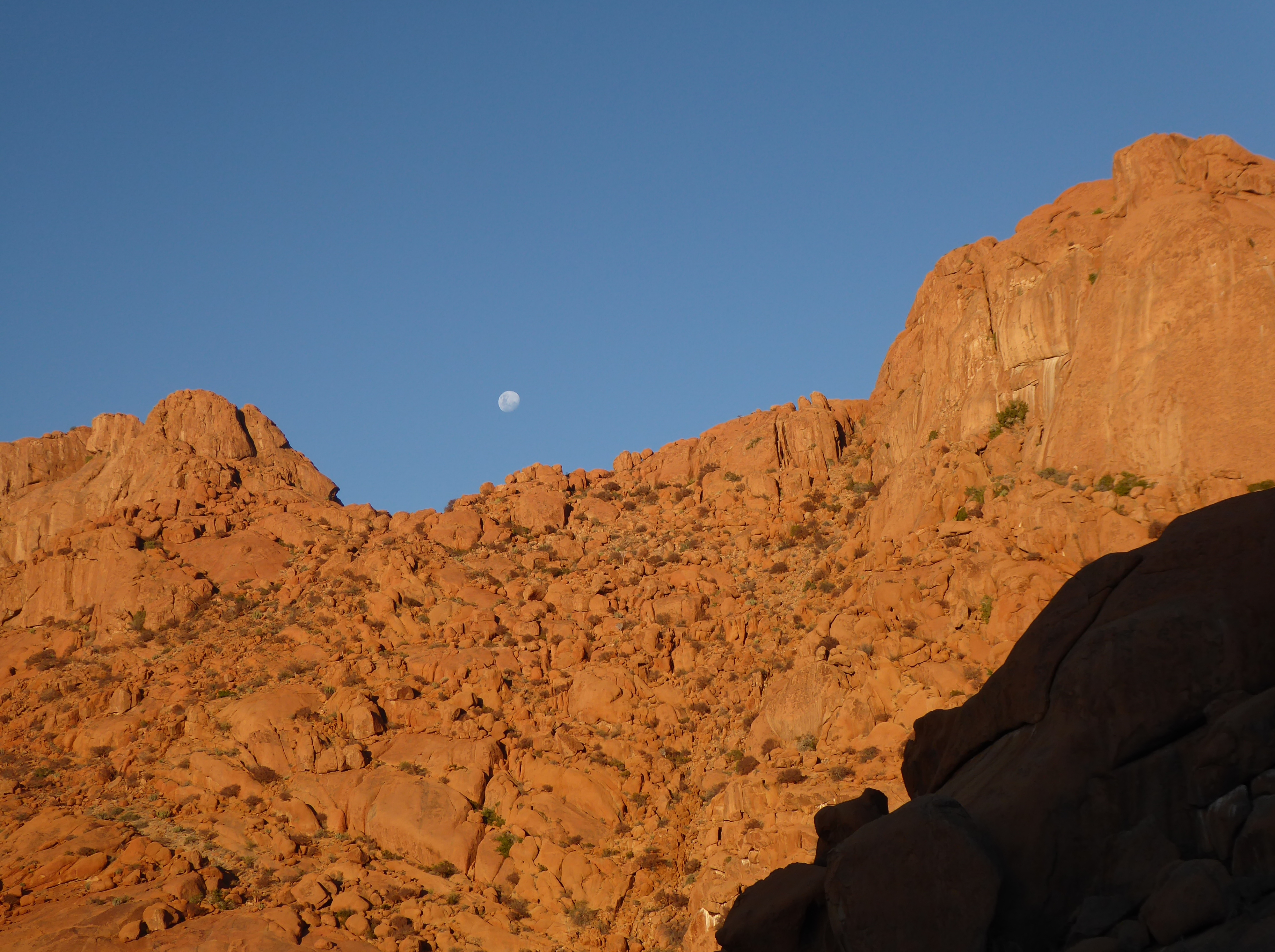
I decided to stay an extra day before heading on to Twyfelfontein. There I passed a night before driving to Palmwag.
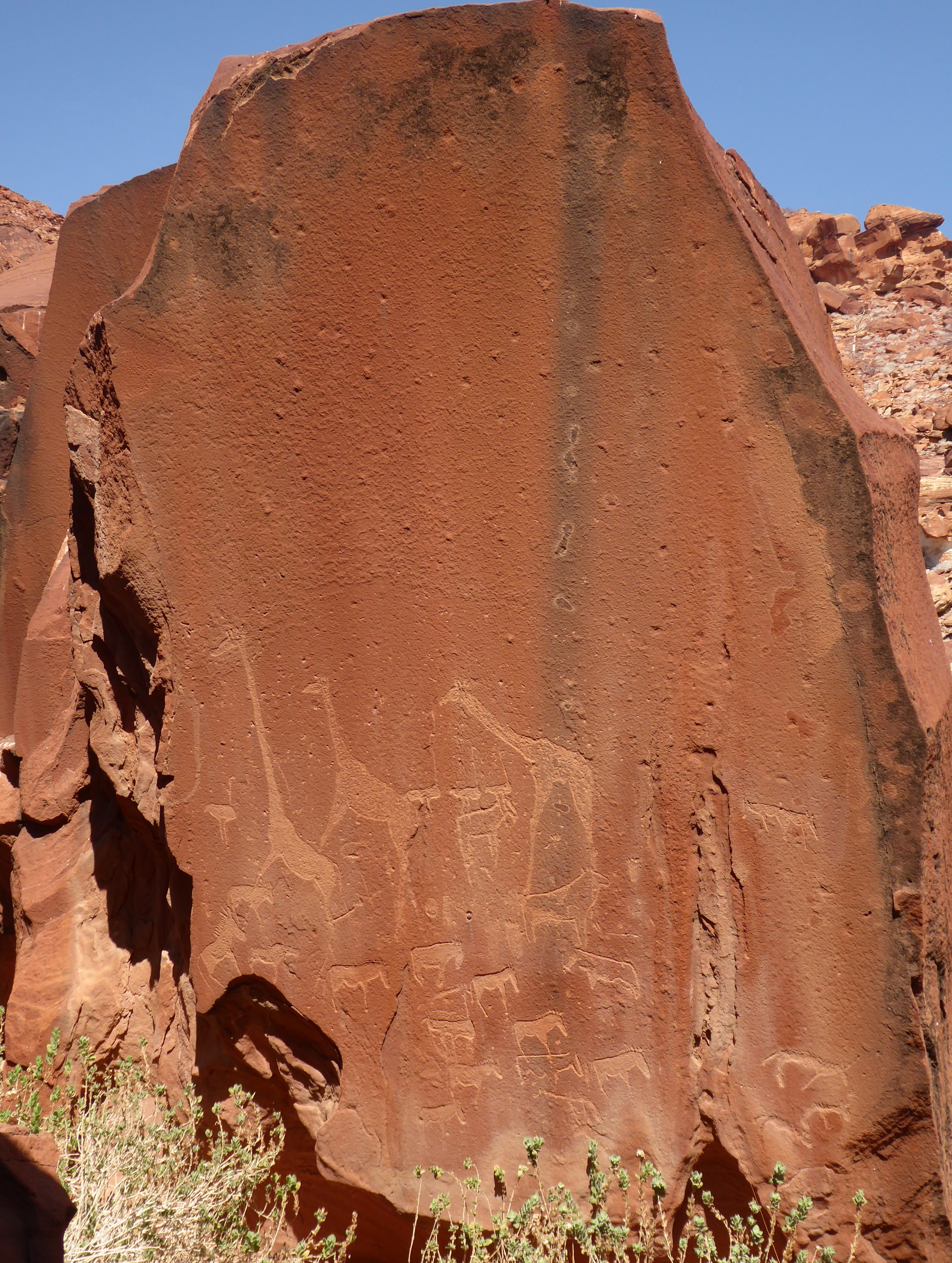
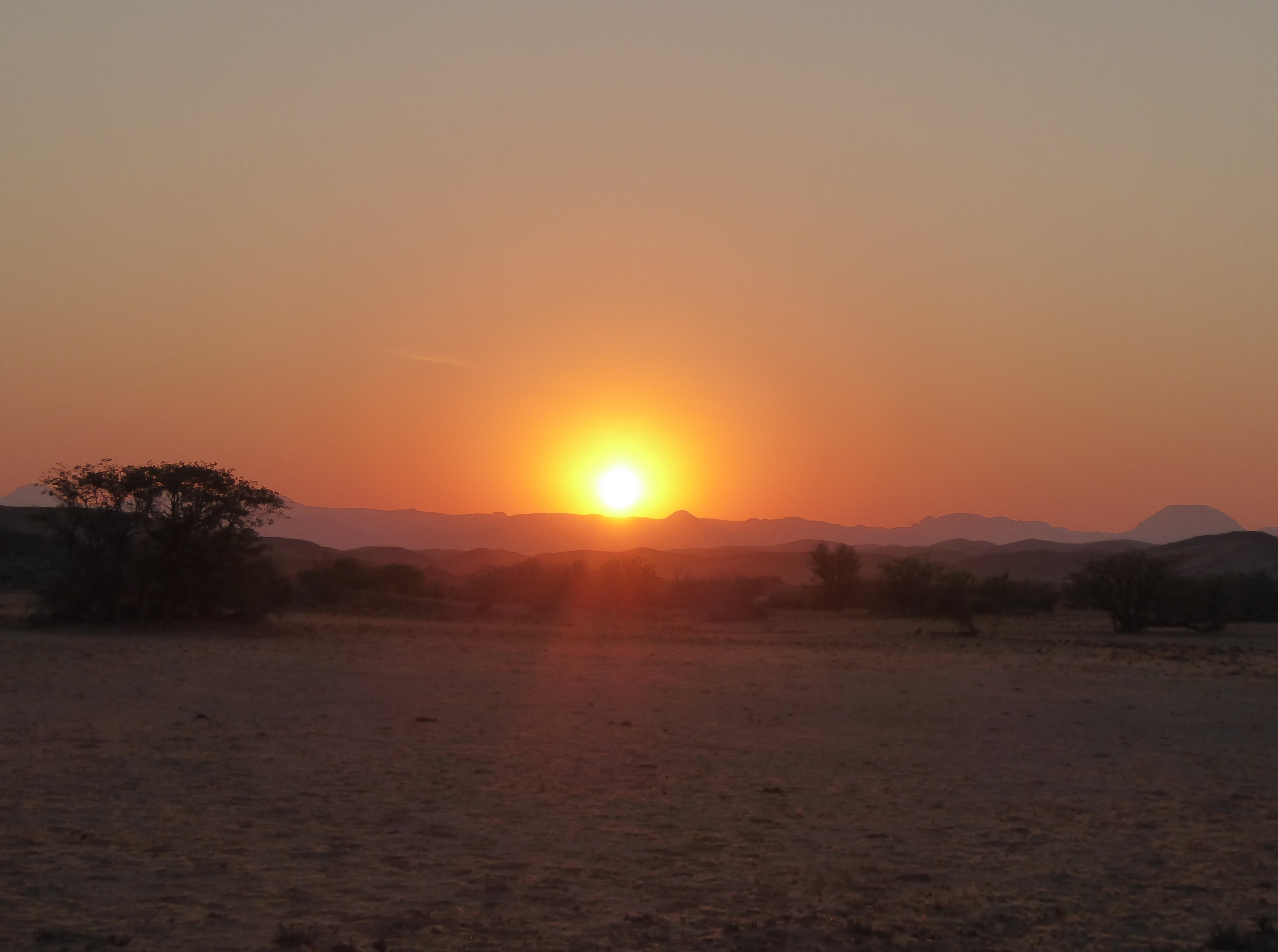
Twyfelfontein and Palmwag offered natural splendor, ancient rock carvings, safari drives, and close encounters with Namibia’s elephants, and rhinos.
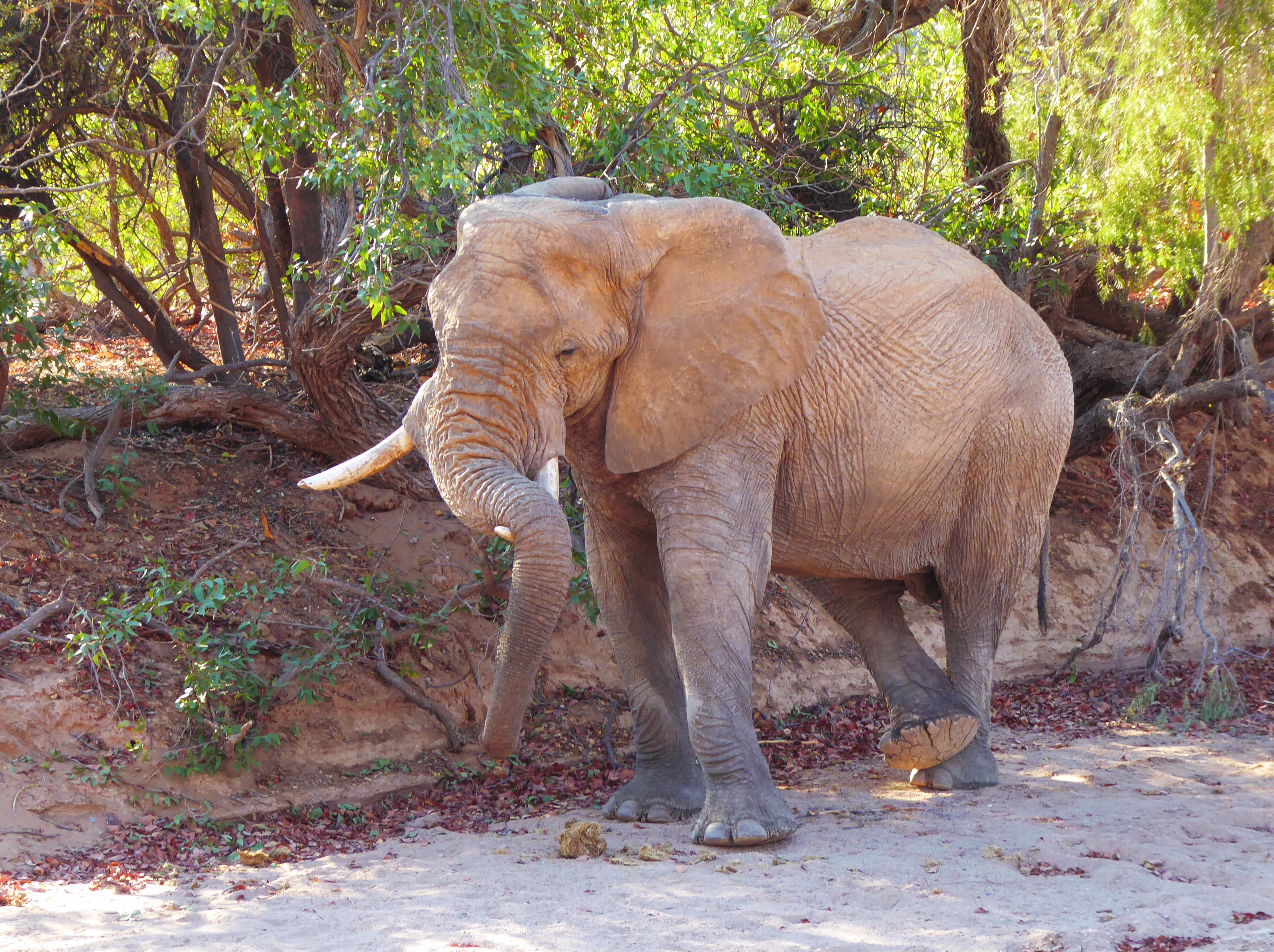
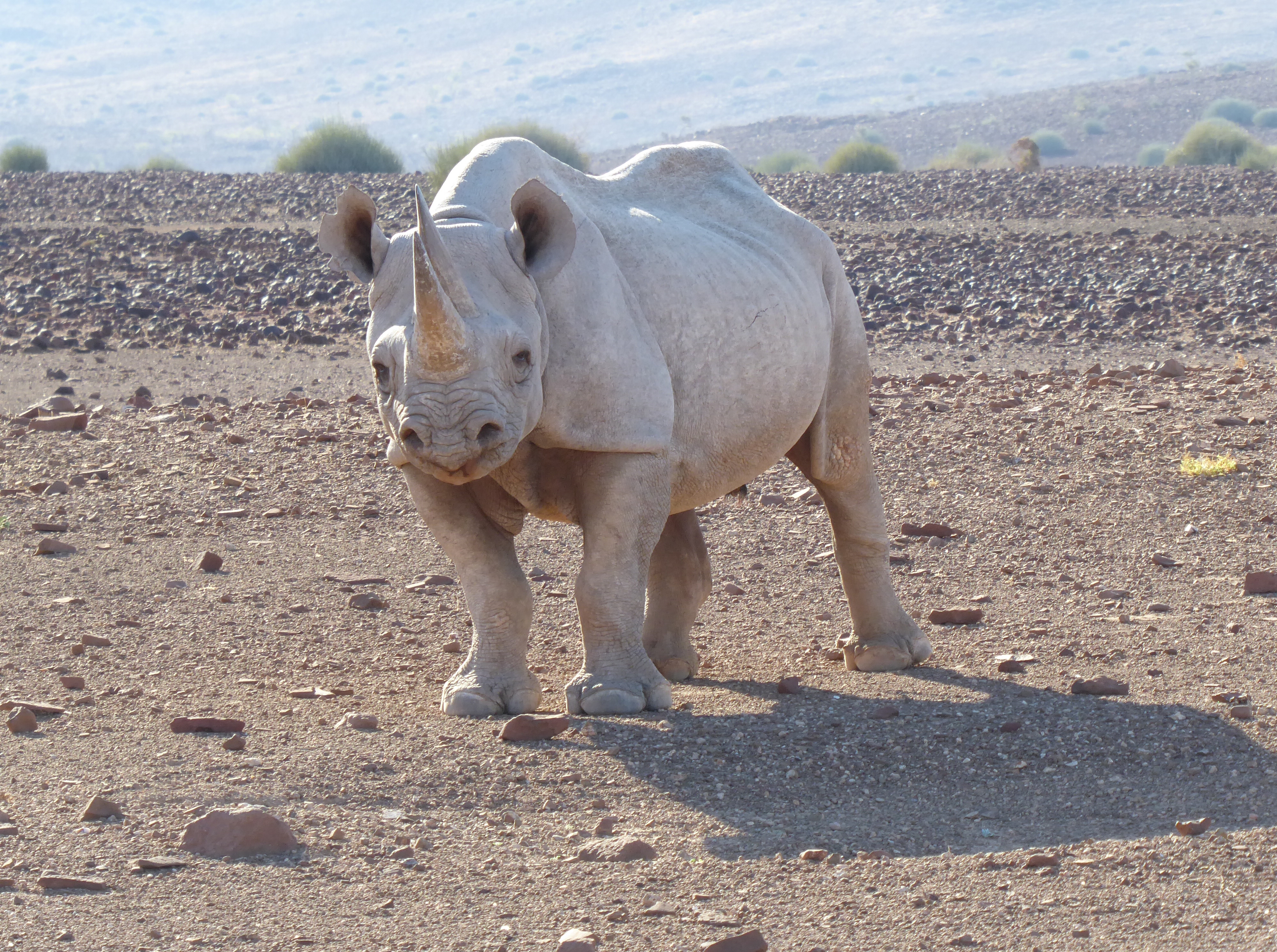
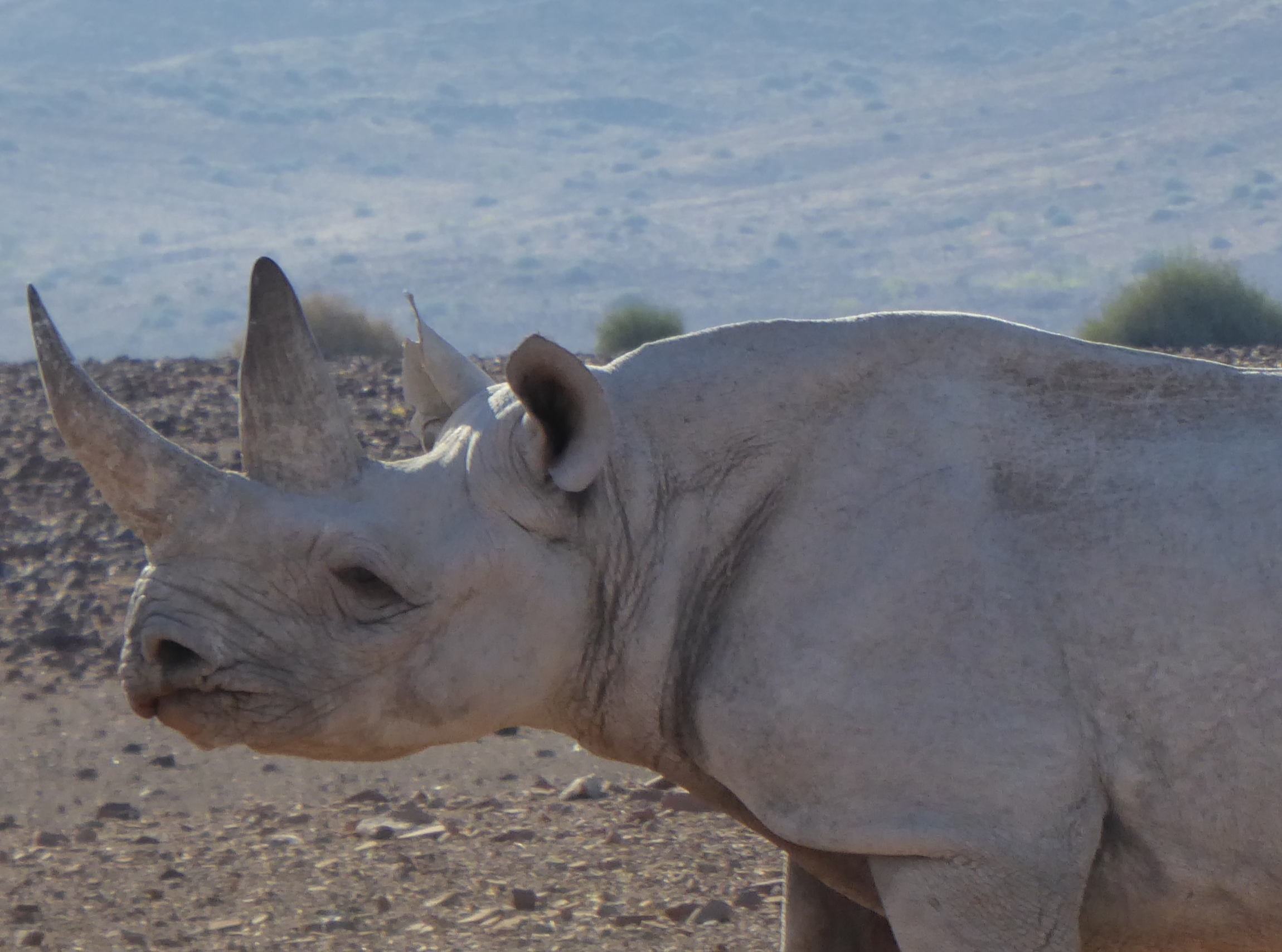
The thrill of seeing these marvelous creatures roaming free made driving on gravel, dusty, rocky, pot-holed roads, and even my second flat tire, worth it.
******
When I was in South Africa driving along the Garden Route, I often saw people standing or walking along the road, holding money in their outstretched hands in exchange for a ride. I passed them by. Many of them were women, all black, often with babes in arms and/or children in tow. It was very difficult not to stop and offer them a ride. Eventually, after careful consideration of each situation, I did.
The scenario, was often the same. The woman would get in the front seat, perhaps with a baby on her lap. I would always have to tell her to put the seatbelt on: the typical transport was open work trucks with no seats nor any security measures. If there were other children, they would get into the back seat, barely containing their excitement. Some of the women could speak some English. Many did not. The children, always quiet and extremely well-behaved, would show their pleasure with their smiles. Before departing they thanked me and offered me their blessings.
The roads of Namibia, offered the same predicament, with one major difference: distances between towns, villages, and settlements were vast, cars and trucks on many of the roads were extremely infrequent, and there was no public transportation. A person could wait for hours before a single car passed by.
I stopped for a boy who knew a few sentences in English and shyly did his best to speak with me; I was waved down to take a sick child and his father to the doctor; I picked up a man carrying a radio, playing what sounded like polka music, walking in heavy work boots toward his destination 30kms away; And here again were mothers with their children, traveling long distances, dusty and tired. I received more thank yous and blessings to last a lifetime.
A woman sitting by the road had two large bags by her side. I asked where she was going. It was in the opposite direction. She had already walked several miles and asked if I had some water. After filling a bottle, I set off and wished her well. I didn’t see a car pass in that direction for another two hours.
******
After many hours, I arrived in Opuwo, a dusty, windy, animated town with long stretches of buildings with little visual appeal and a dearth of cafes and restaurants.
However, the Hereo, Himba, and other tribes who reside there, come in for provisions, and/or sell trinkets to tourists often just passing through, offer a fascinating experience in Namibian cultures. The women were most distinguishable by their attire: the Hereos wore large colorful fabric dresses and hats,modeled from the German settlers; Himbas with reddish skin from applying a mixture of ochre and butterfat, were bare-breasted, wearing short skirts of animal skin, intricate hand-made necklaces, ankle bracelets, and adorned long braids; various other tribeswomen wore westernized style skirts, some with only a bra for a top, or dresses; some had closely cropped hair and others wore braids adorned with some beads.
I spent a night in the Abba Guesthouse, about a fifteen walk from the center shopping area in Opuwo, where I passed about eight churches strolling between the two. The owners were a missionary couple from Europe who’d built a church, founded a school and orphanage many years ago, and had more recently started a guesthouse on the same property. The accommodations were simple, but comfortable, and I enjoyed hearing the laughter of children playing outside. The password for the wifi was easy to remember: Jesus.
V. On the Road: Week Four ( Epupa Falls to Etosha National Park)
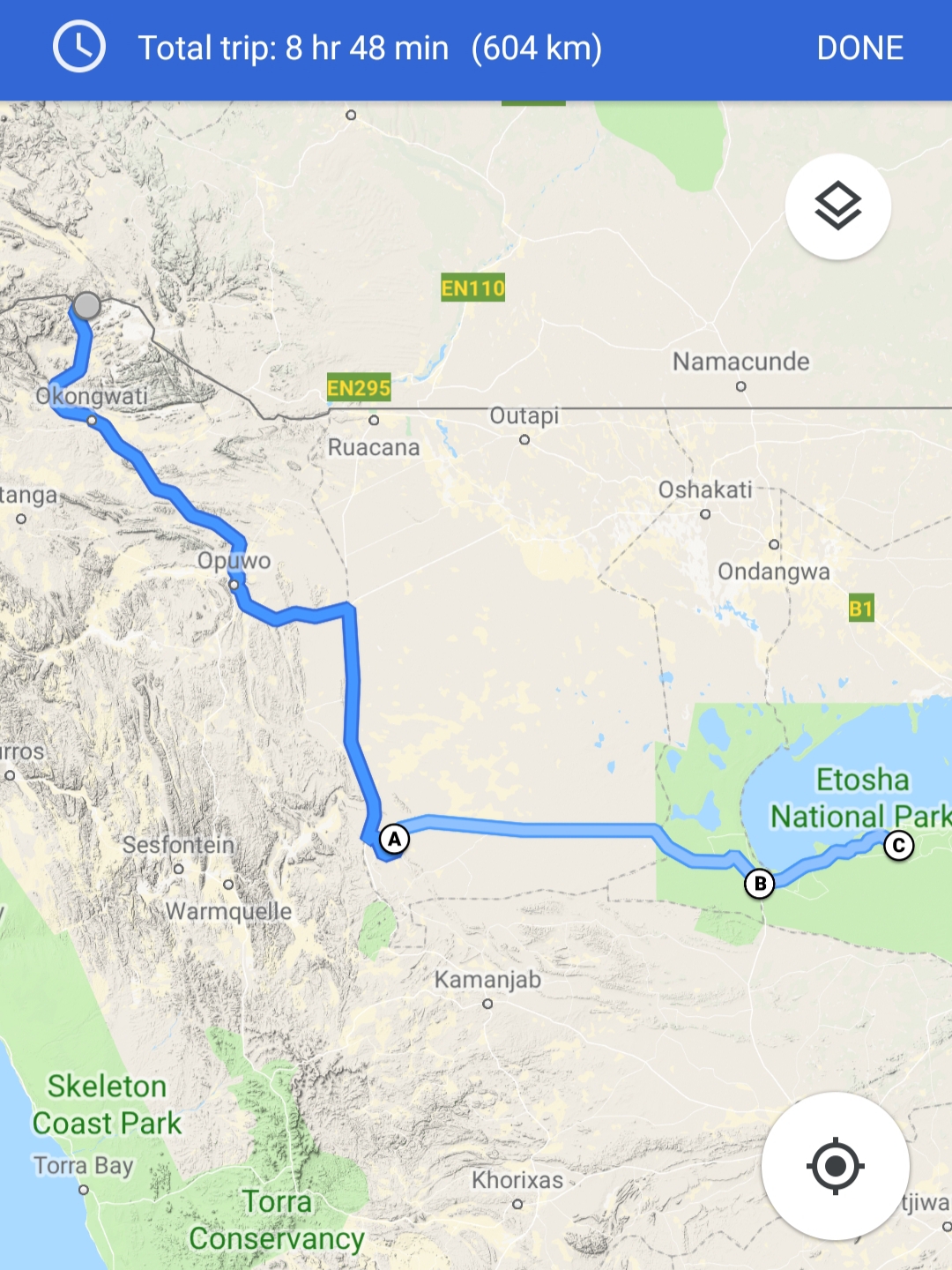 Epupa Falls, Etosha( Dolomite, Okaukuejo, Halali)
Epupa Falls, Etosha( Dolomite, Okaukuejo, Halali)
After a long drive from Opuwo, over arid lands on difficult, broken, dirt and gravel roads, suddenly patches of shrubs, marsh grasses, and trees appeared. I was nearing the Kunene River and Epupa Falls. The river, which separates Namibia from Angola, was wide and flowing well. Monkeys, crocodiles, multitudes of birds, at least one huge, but elusive, monitor lizard,and other wildlife were reaping the benefits of its life-giving force. My senses, after a lengthy deprivation of greenery, hungrily soaked it in.
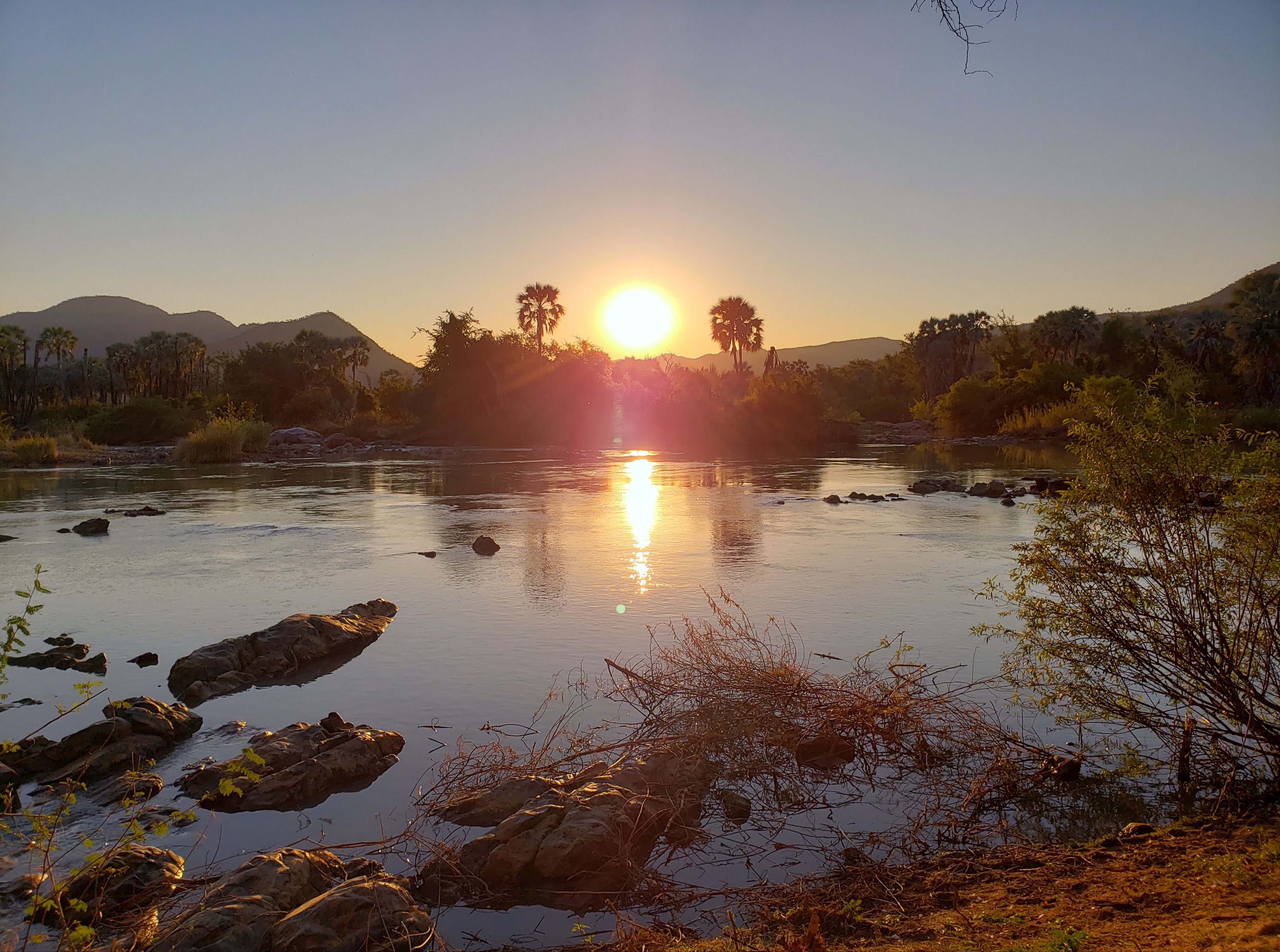
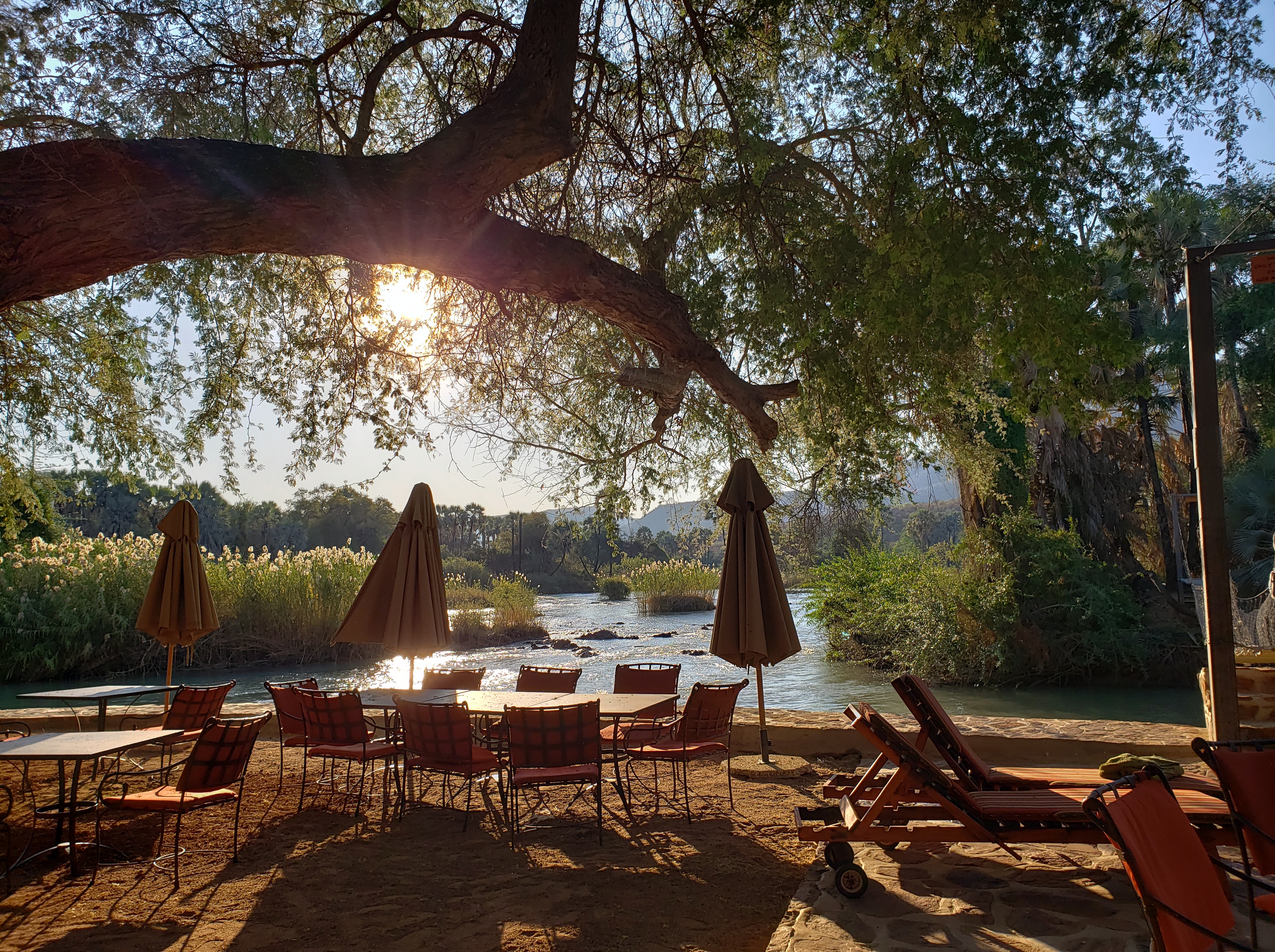
Epupa Camp, which lies right on the banks of the river and just a short walk to the falls, was an ideal place to stay and explore the area, most notably the Himba villages.
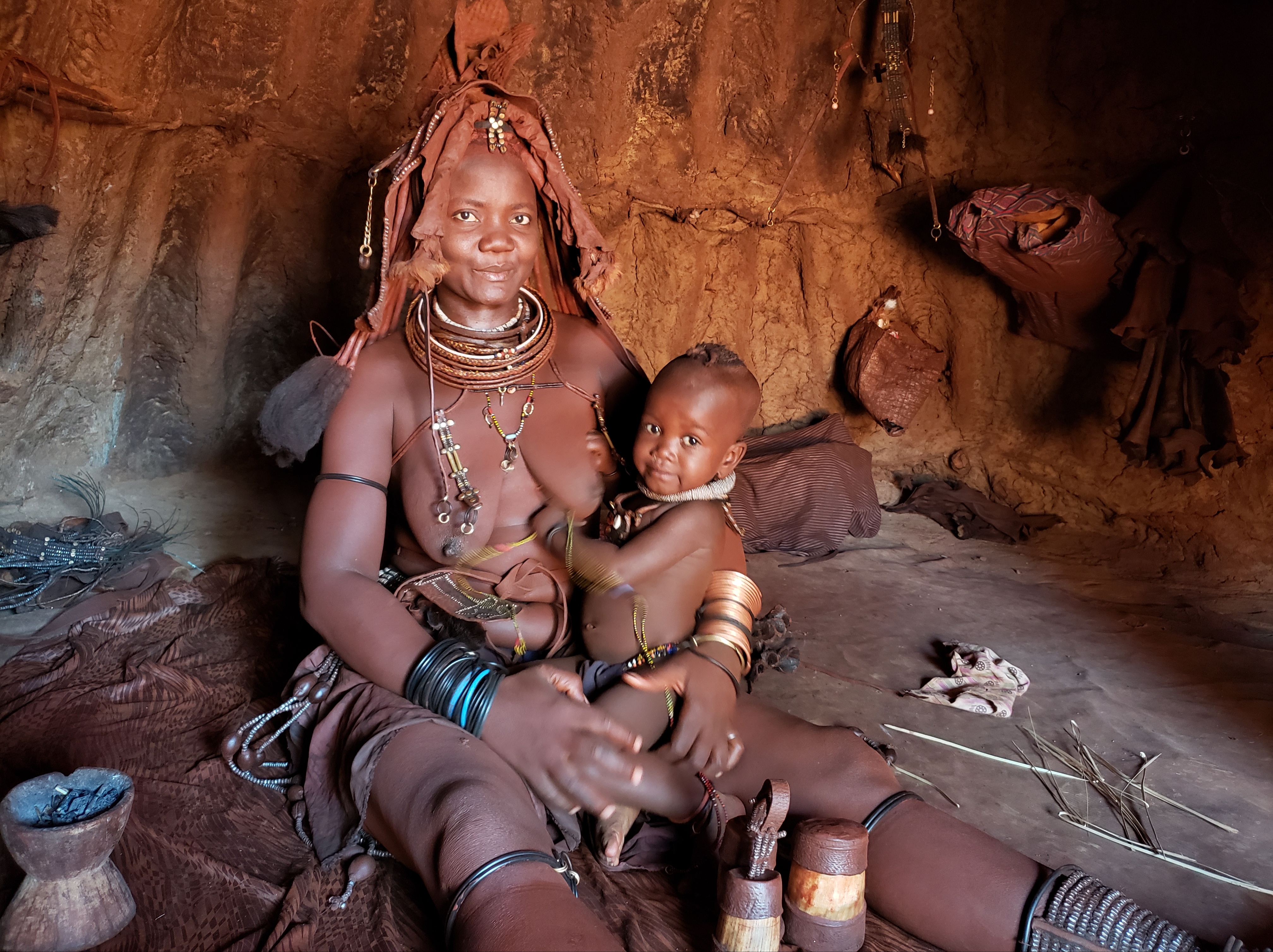
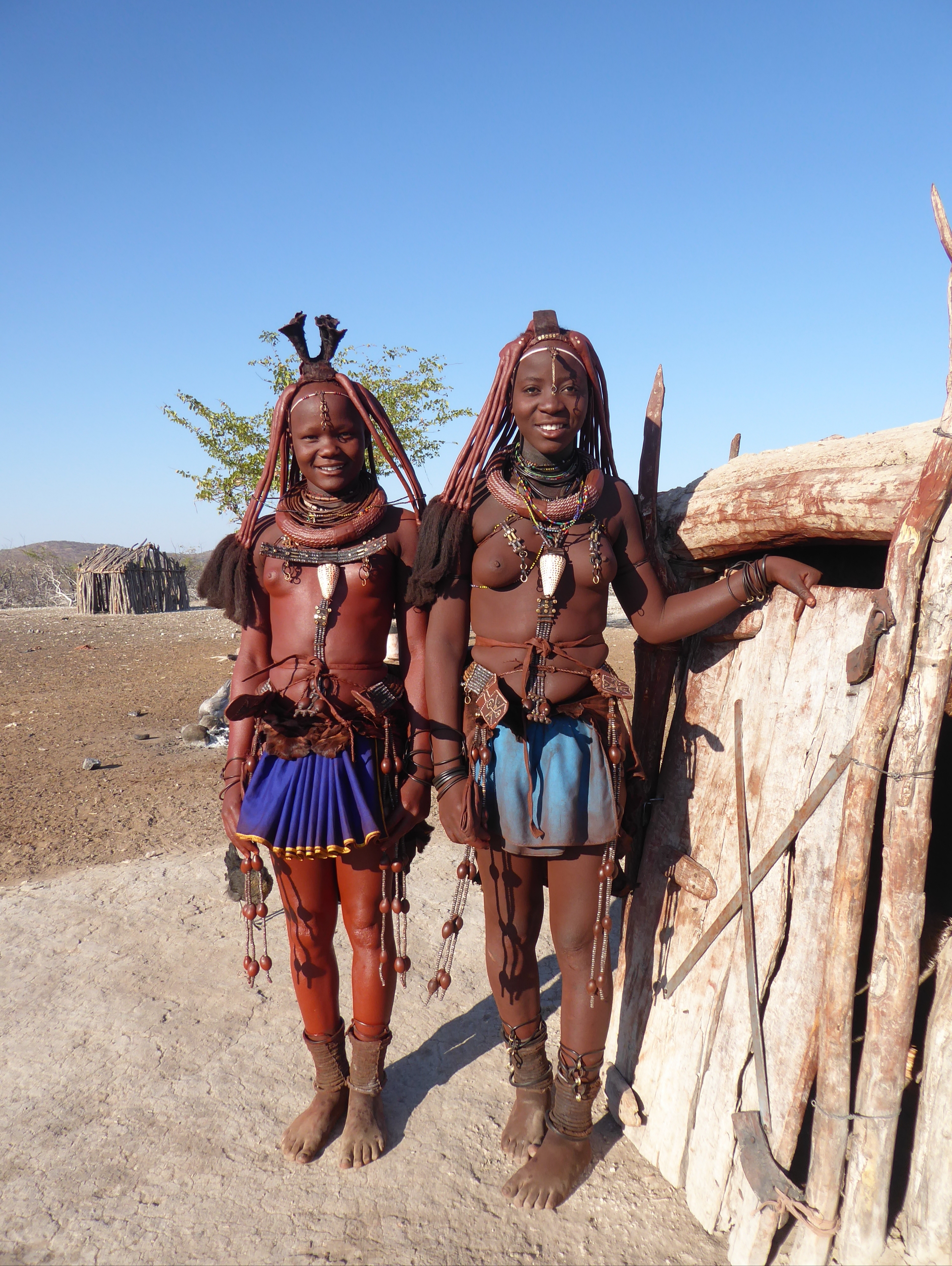
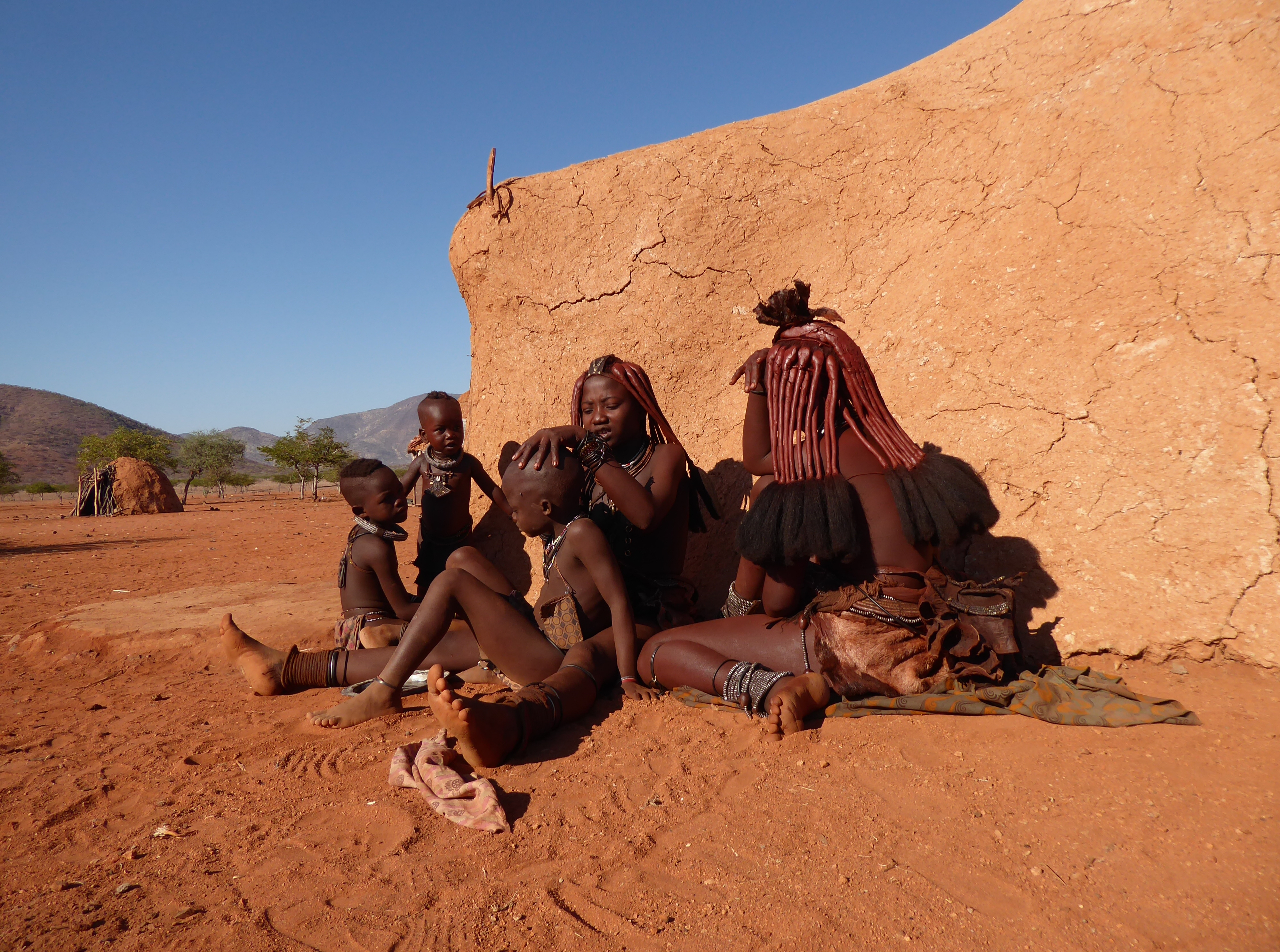
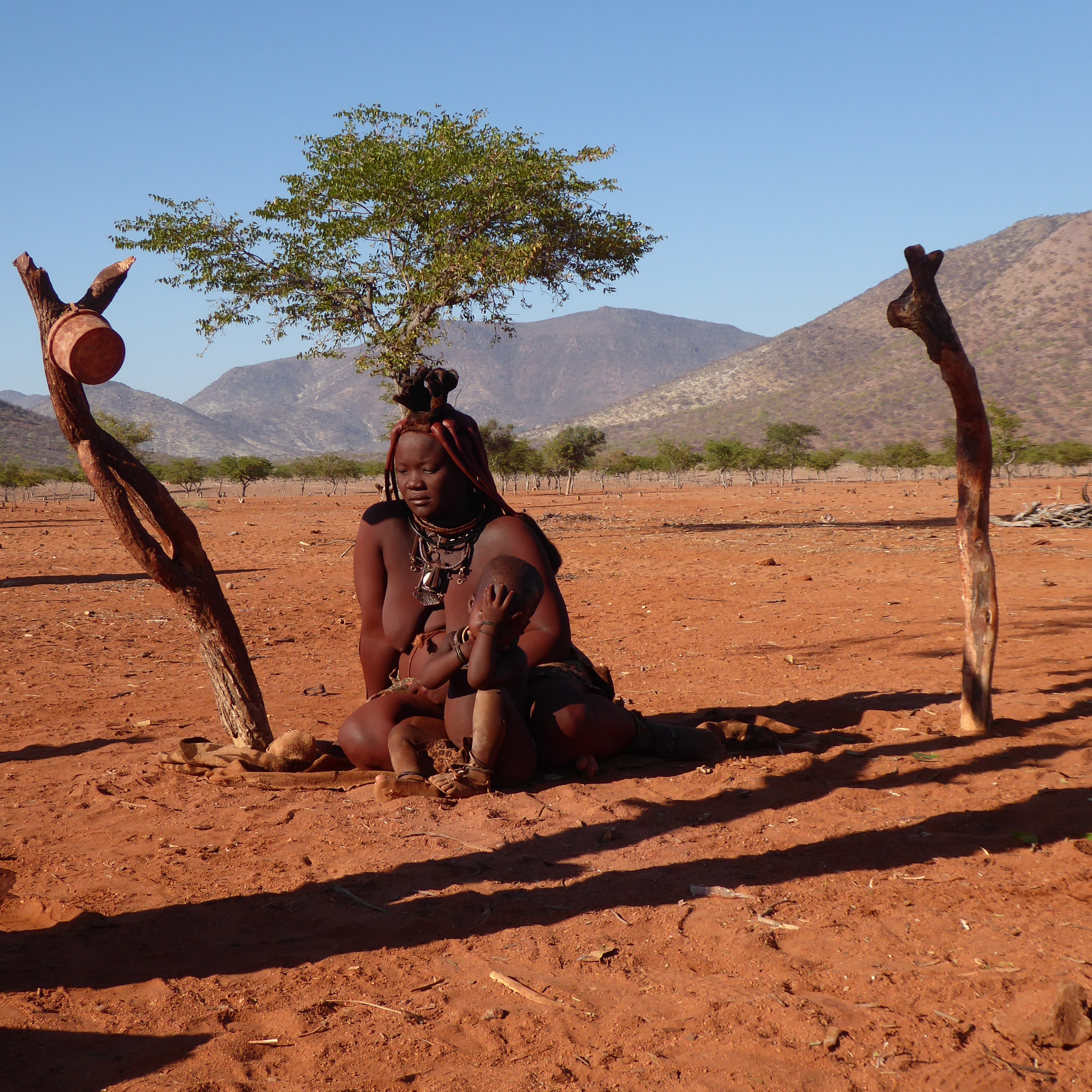
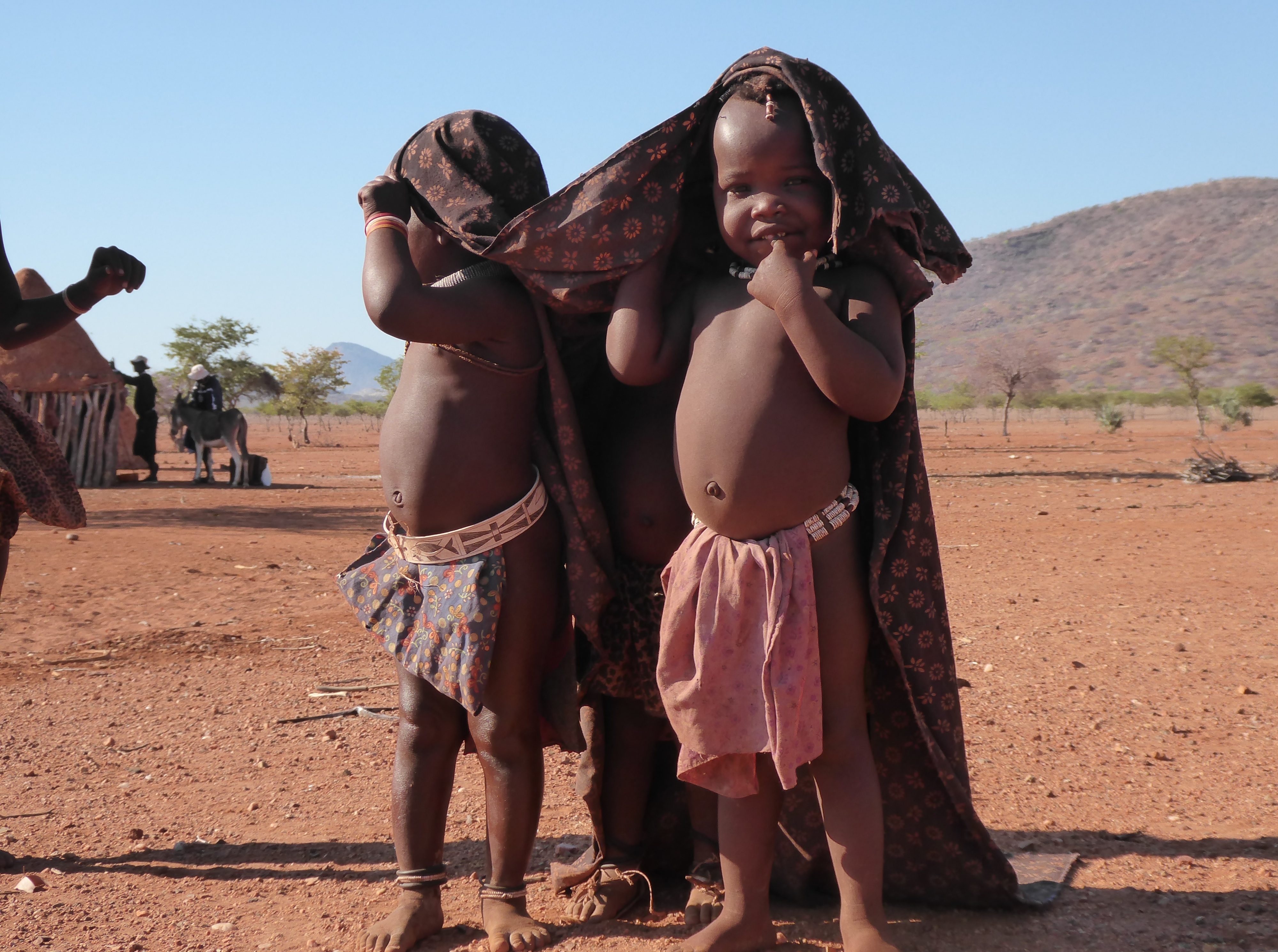
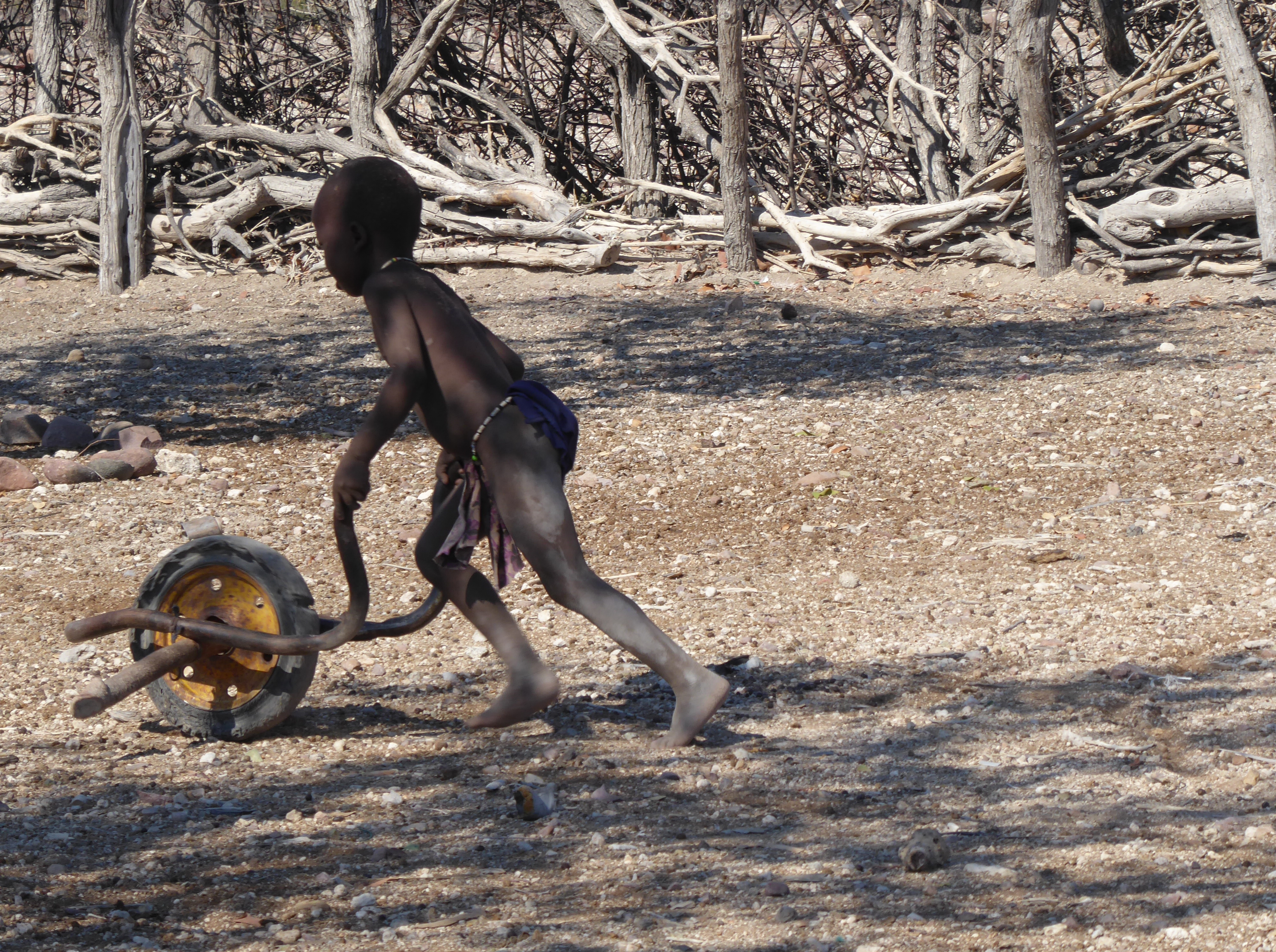

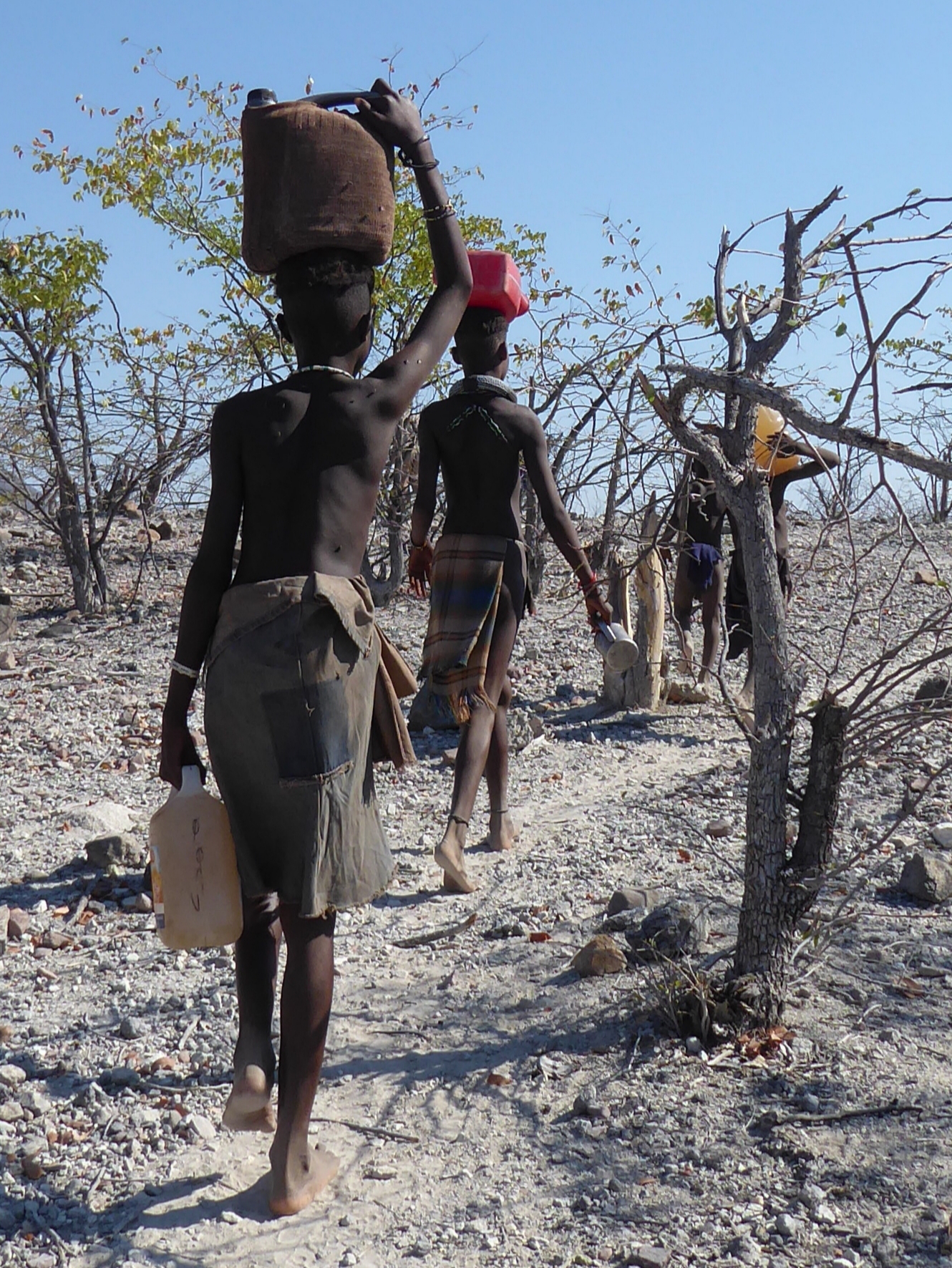
Visiting the Himbas and their villages was an extraordinary experience. It gave me a glimpse into an ancient way of life and perhaps one of the purest.
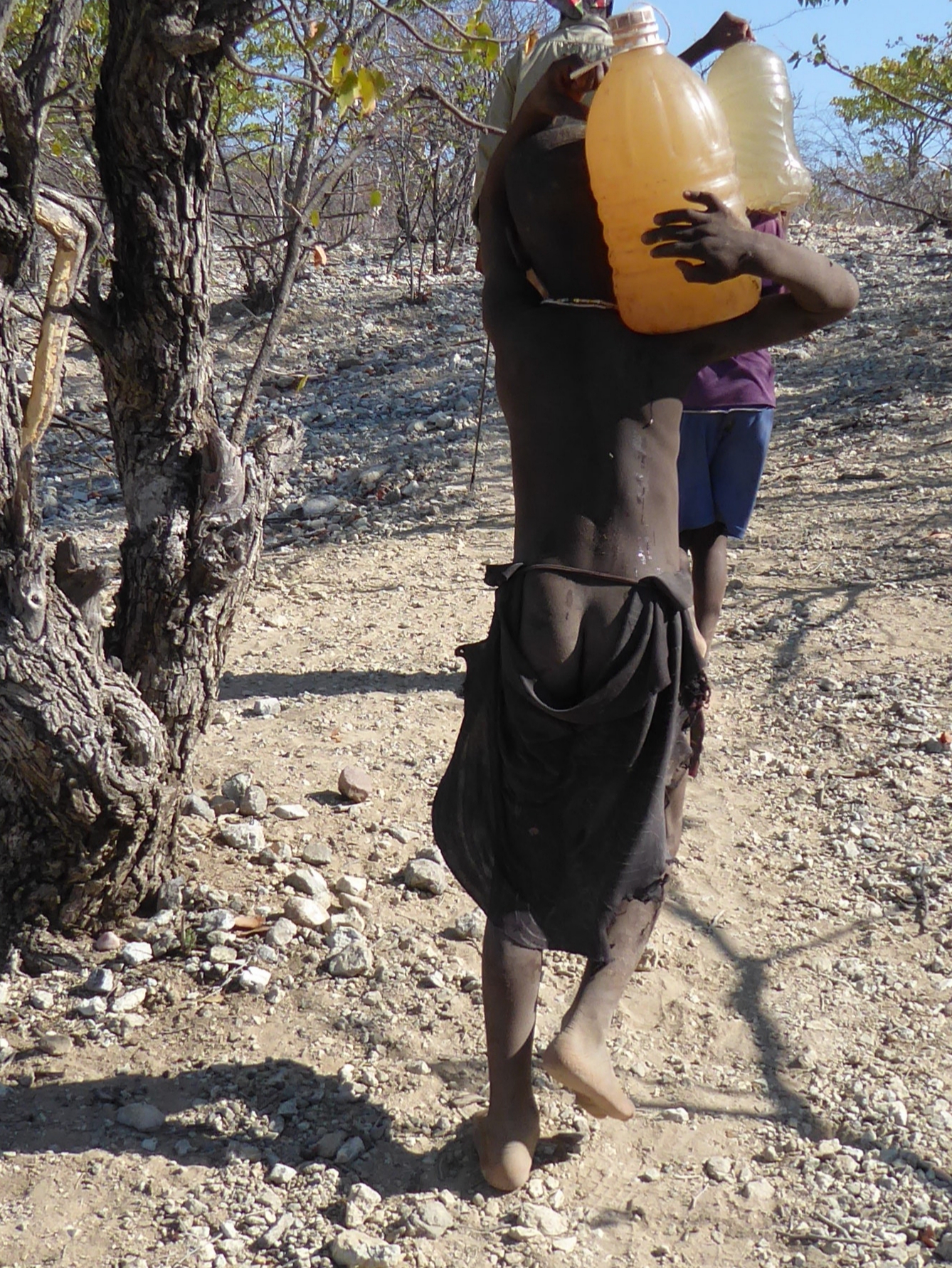
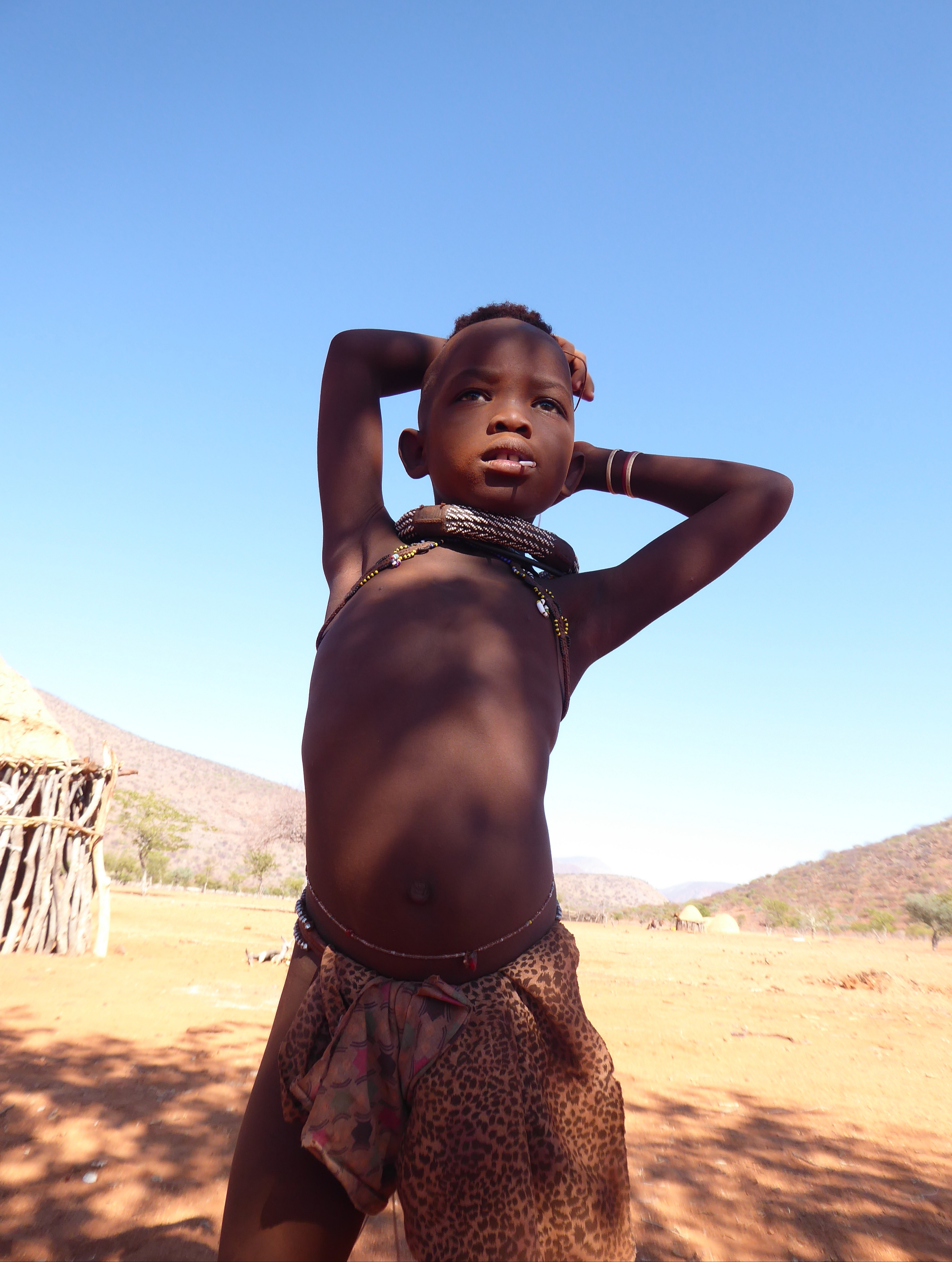

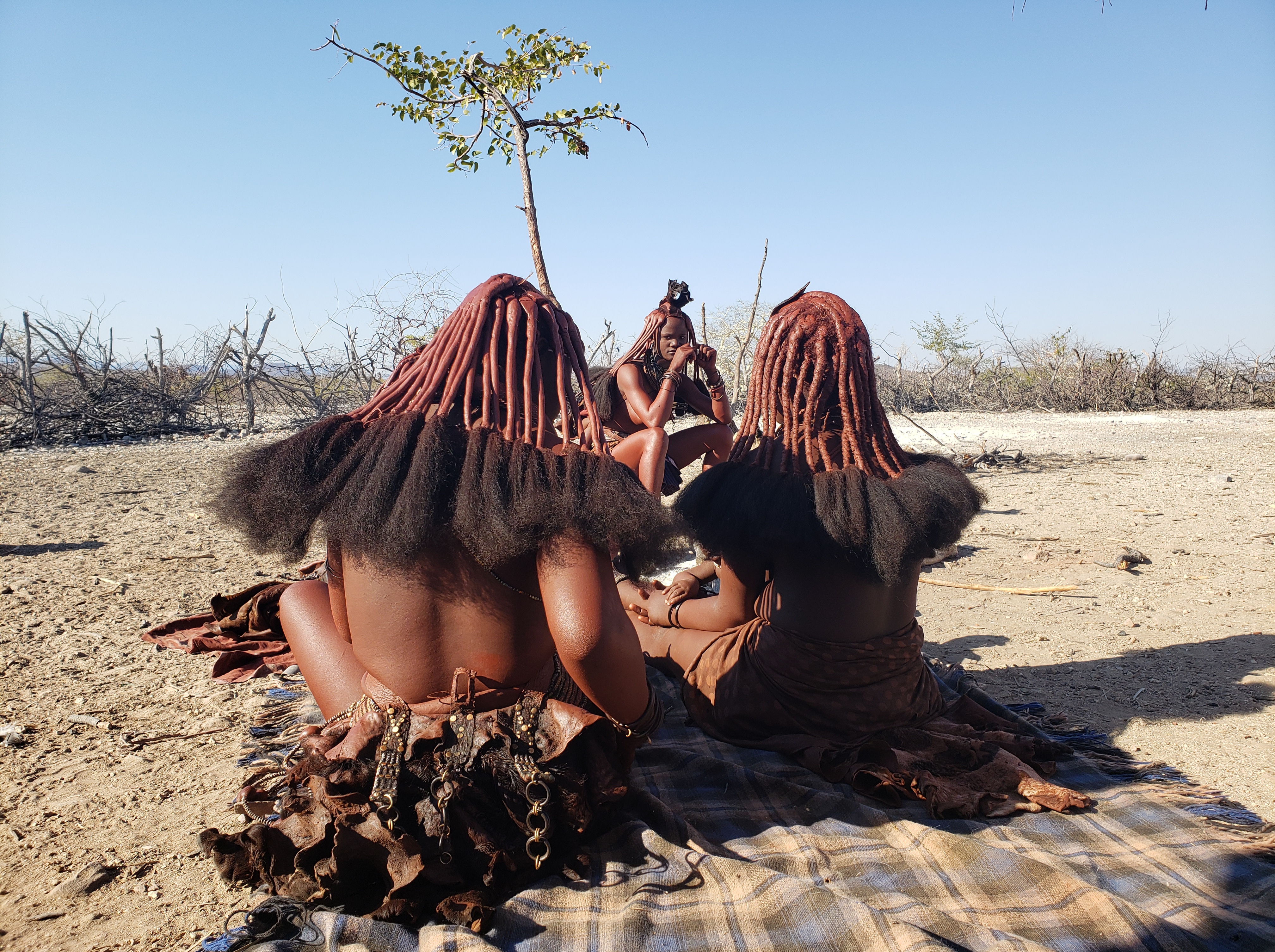
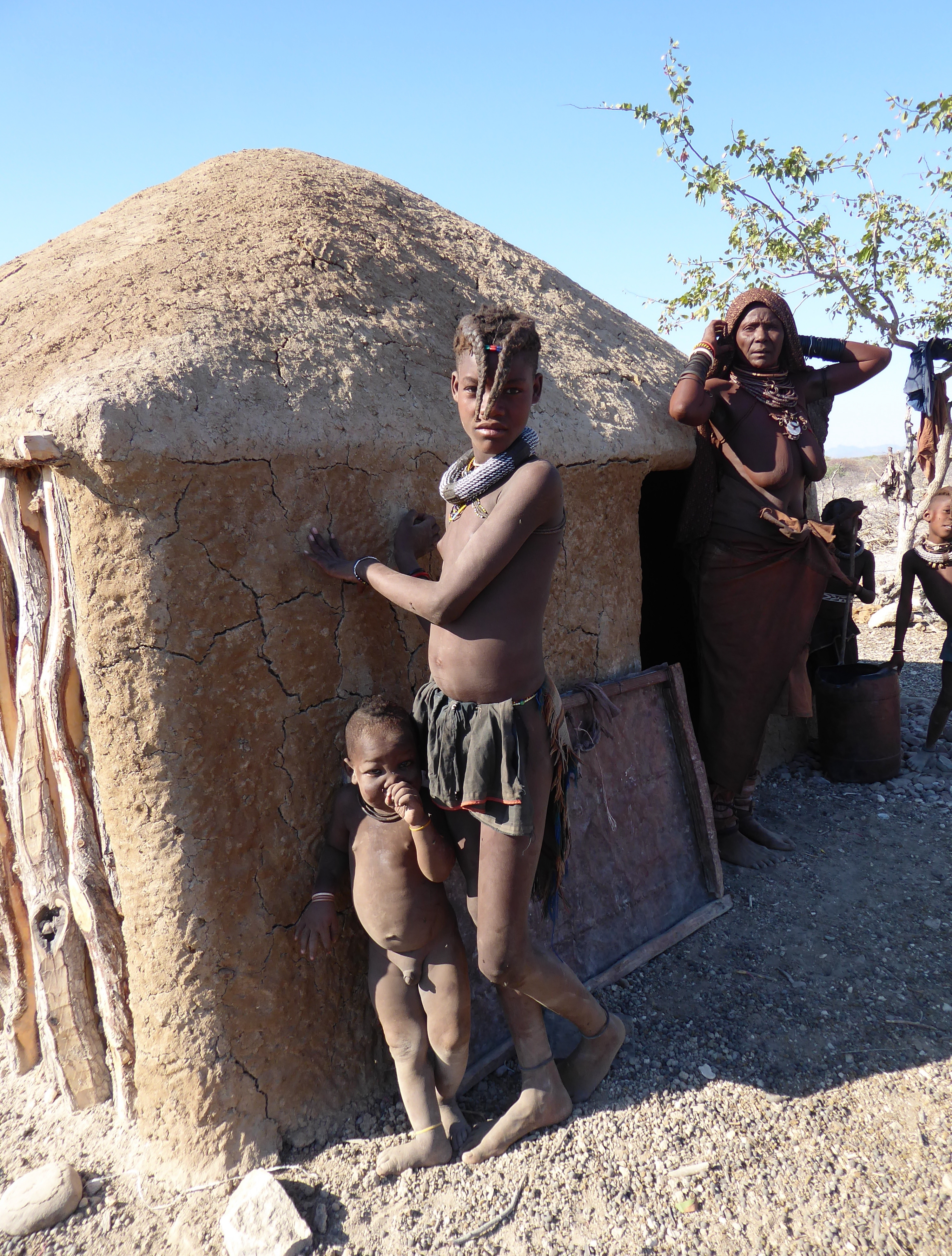
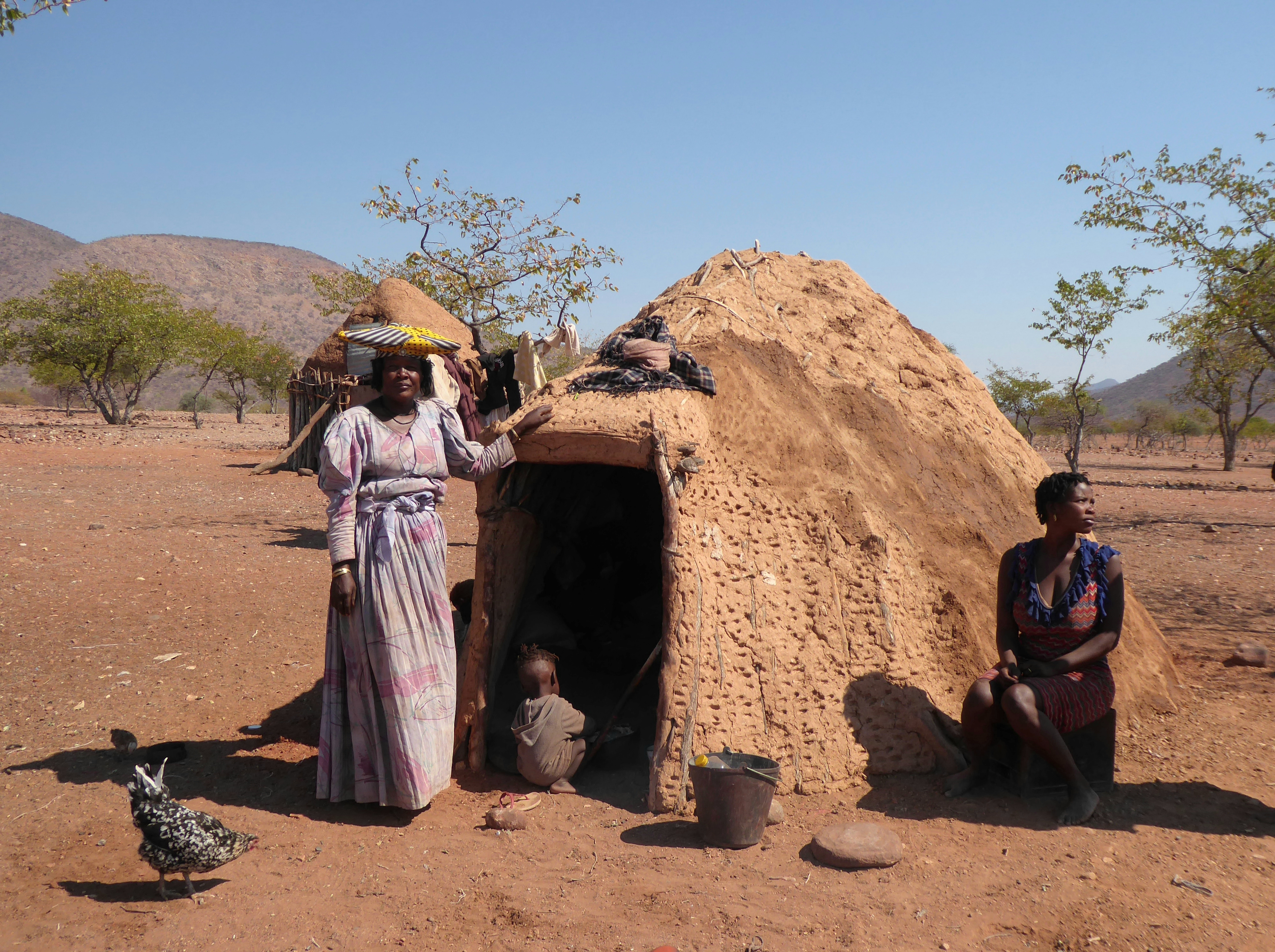
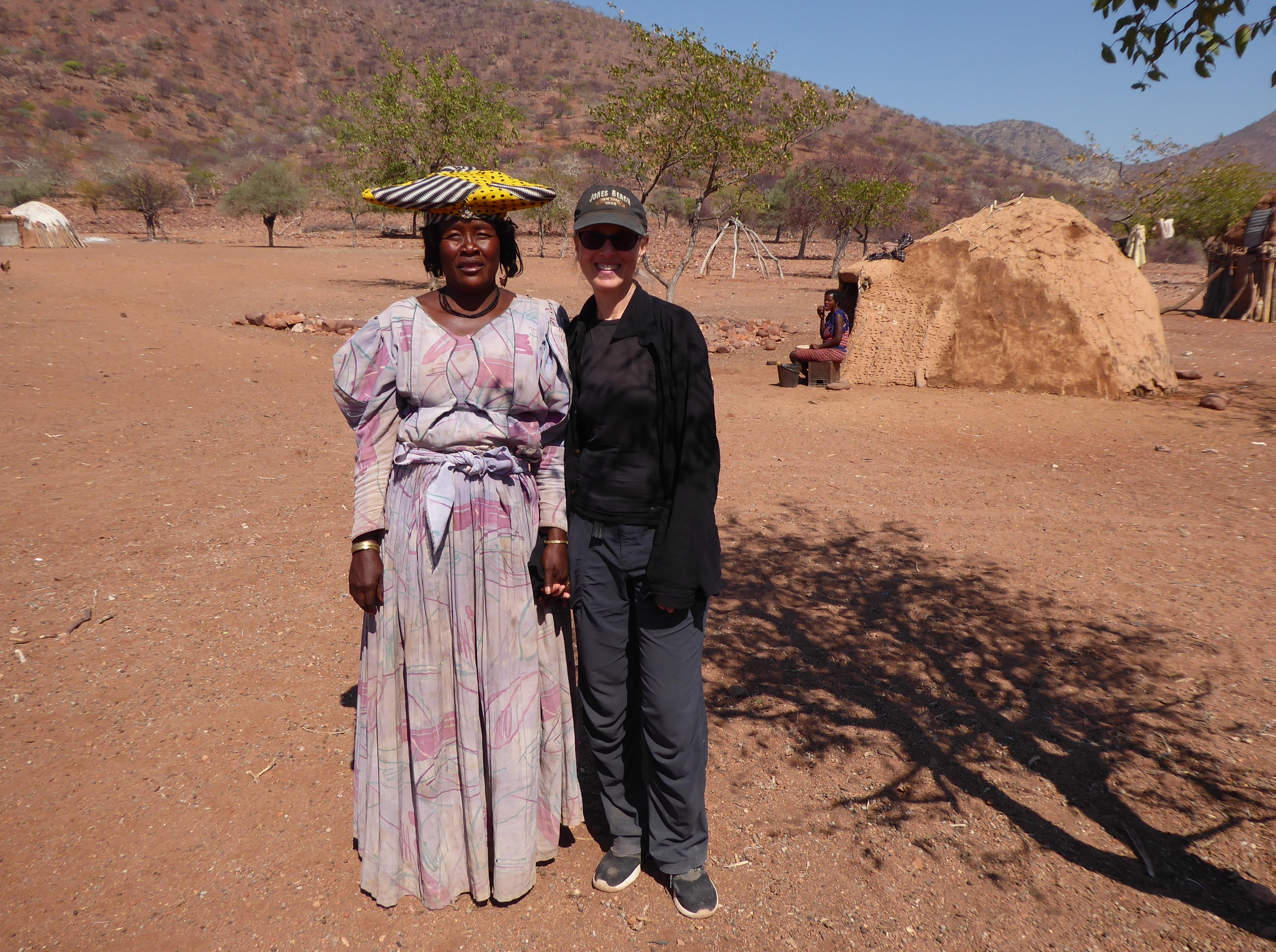
Each encounter moved me greatly.
I was in the company of a guide/translator who was Himba and shared his life story: At ten years of age, while tending his herd of goats, he met a boy who could read. He had no formal education (it is generally frowned upon as a threat to the Himba’s traditional way of life) and felt compelled to run away to get one. He hitched a ride to a school, hours away, without telling his parents, and asked to be admitted. He had never held a pencil, did not know the alphabet, nor had he ever worn a pair of shoes. Despite the difficulties adjusting to a foreign world, and lacking the mandatory uniform, his dedication and abilities were quickly noted. He was given the basics to stay on.
After two weeks, the teachers went back to his village to speak with his family. His father nearly beat the teachers, but was convinced to let him stay. Making a toy helicopter that could fly, by himself, brought him to the attention of a Swiss man. This man seeing his promise offered to pay for his advanced studies. After obtaining a degree in mechanical engineering and living in Windhoek, far from his family and culture, he decided to return home and began working as a tour guide. The same Swiss man is currently paying for his sister’s education–without any protest from the father.
My time in the villages broadened my perspective of the human experience. Despite their basic way of life, I pondered the richness of their lives in comparison to my own.
******
At Epupa Camp I cherished the moments watching and listening to the river flow, being entertained by monkeys who scampered and played in the same tree that cast my shade, and reveling in the sweeping display of stars.
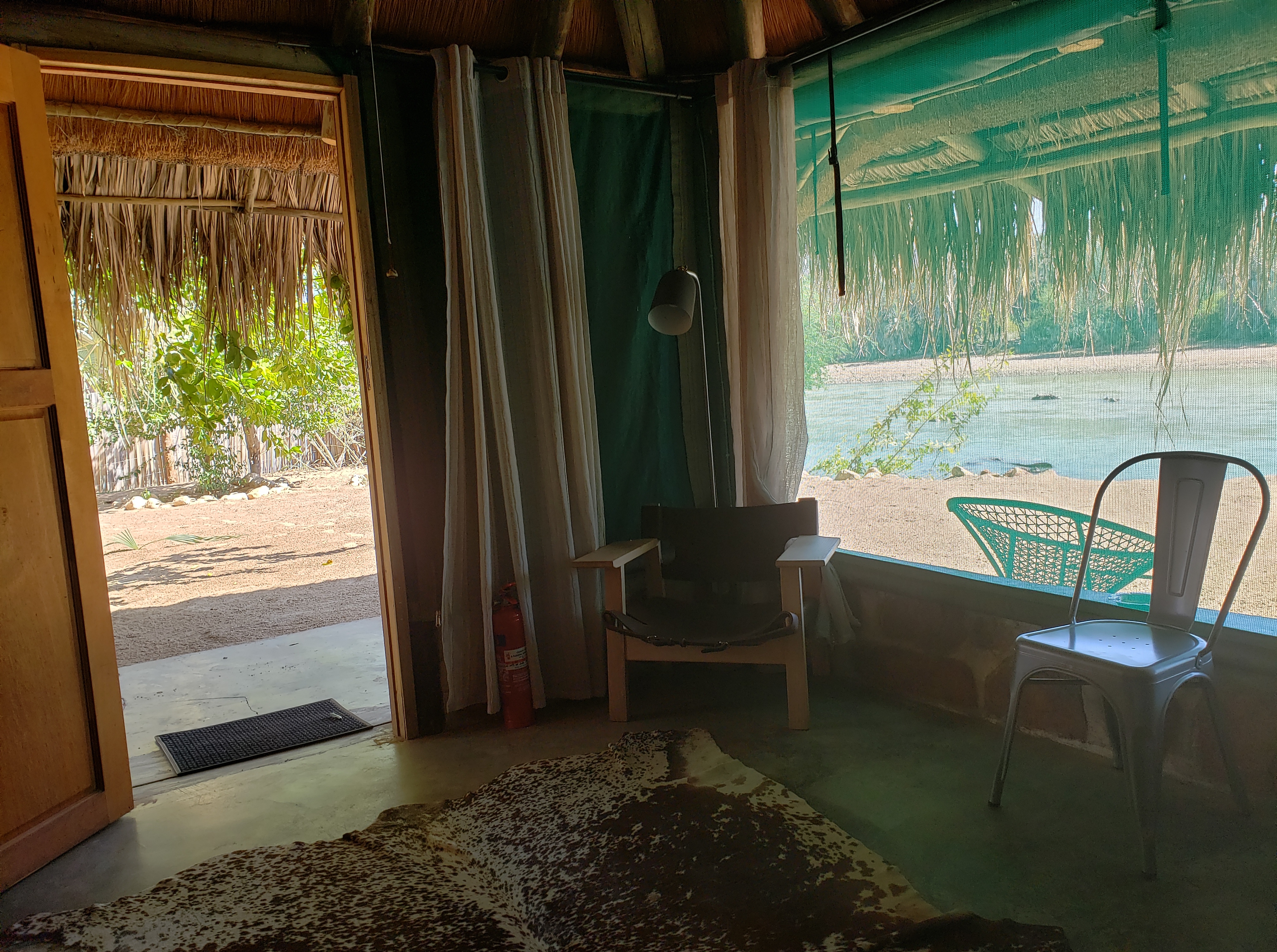
******
After a stay I could have easily prolonged, I took the same long road back to Opuwo, and continued on to Etosha where accommodations had been arranged.
Etosha, about the size of Switzerland, is a primary tourist destination in Namibia. I didn’t know much about it, except like everyone else, I’d hoped to see a range of animals roaming in their natural habitat. Not far from the entrance a herd of zebras ran in front of my car, warthogs scurried along the roadside, and a rhino grazed a short distance away.
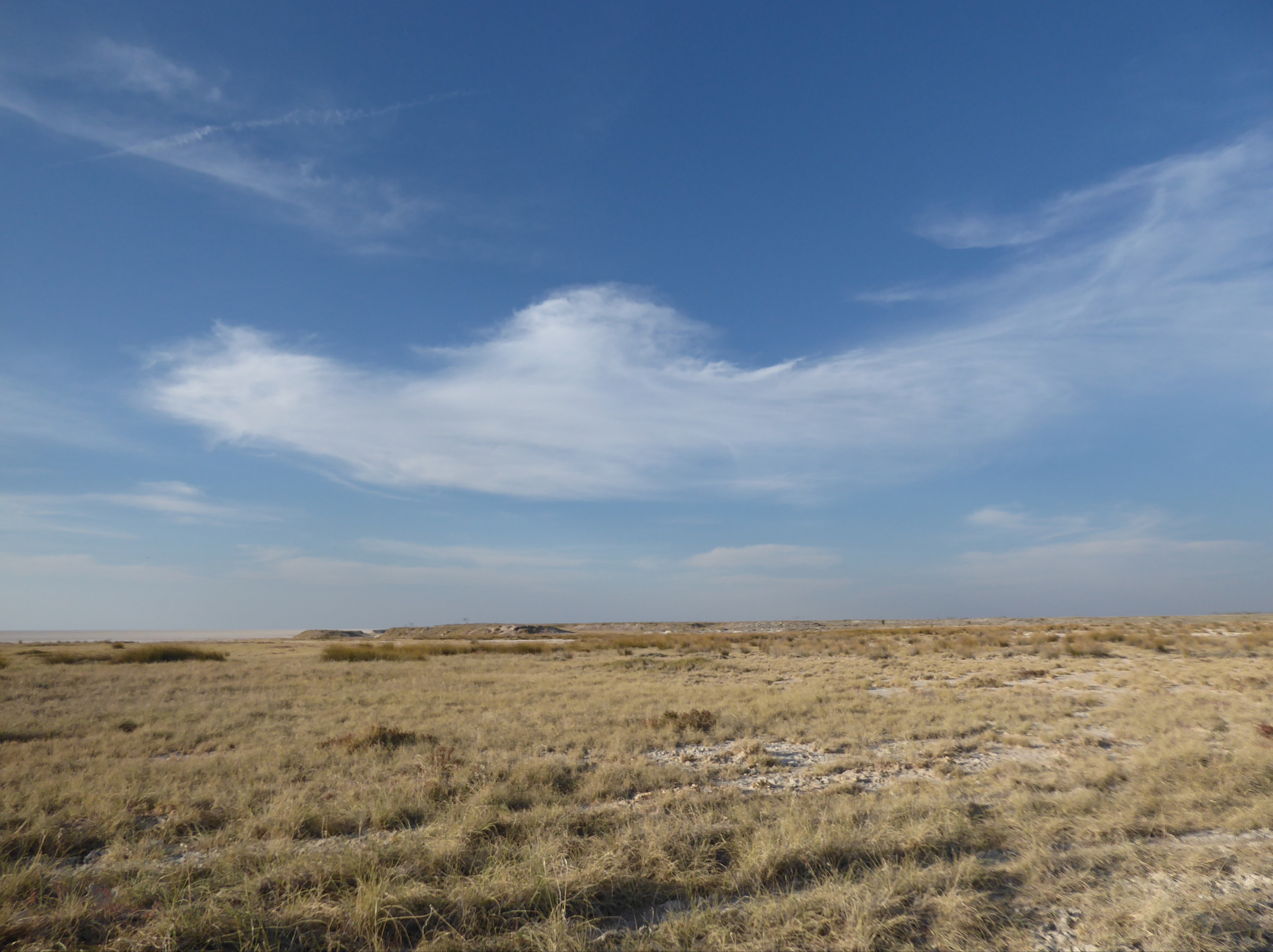
Each day in Etosha offered extraordinary encounters with exquisite animals and insight into the animal kingdom. My breath was often held in excitement and taken away.
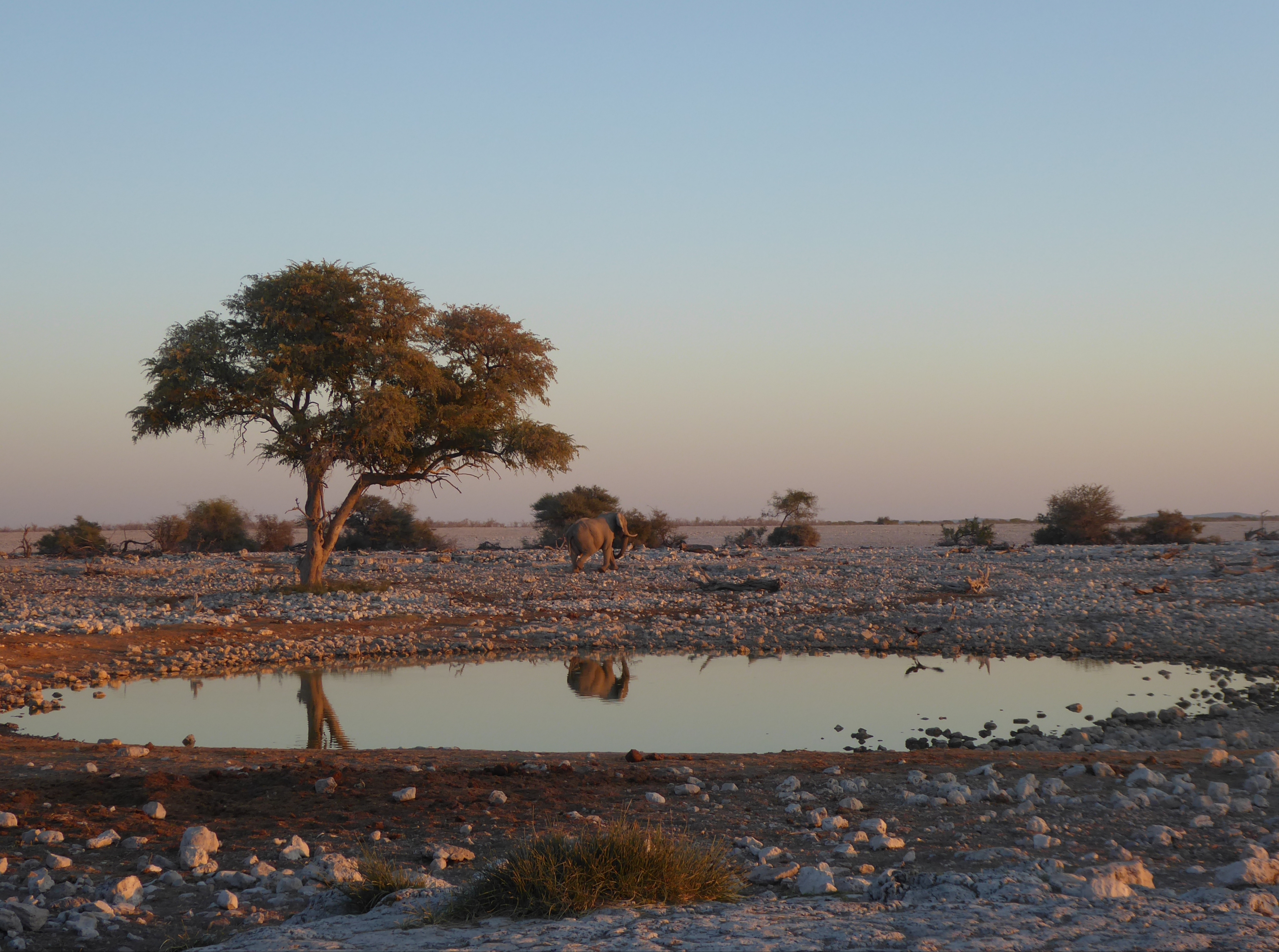
The area was fenced, but visitors could linger for hours on benches. It was like a one ring circus, where entertaining “acts” would be punctuated with “intermissions” of inactivity.
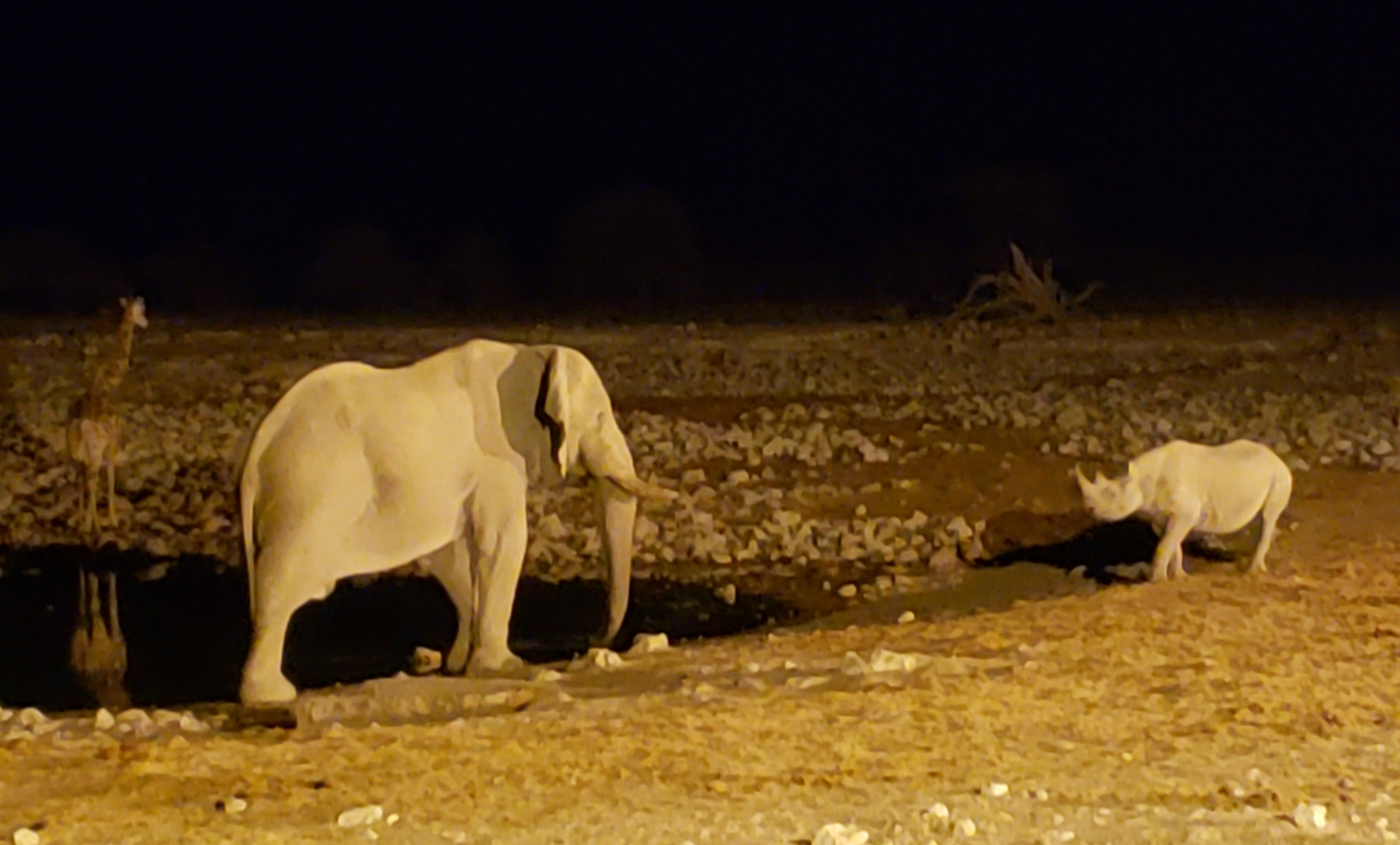
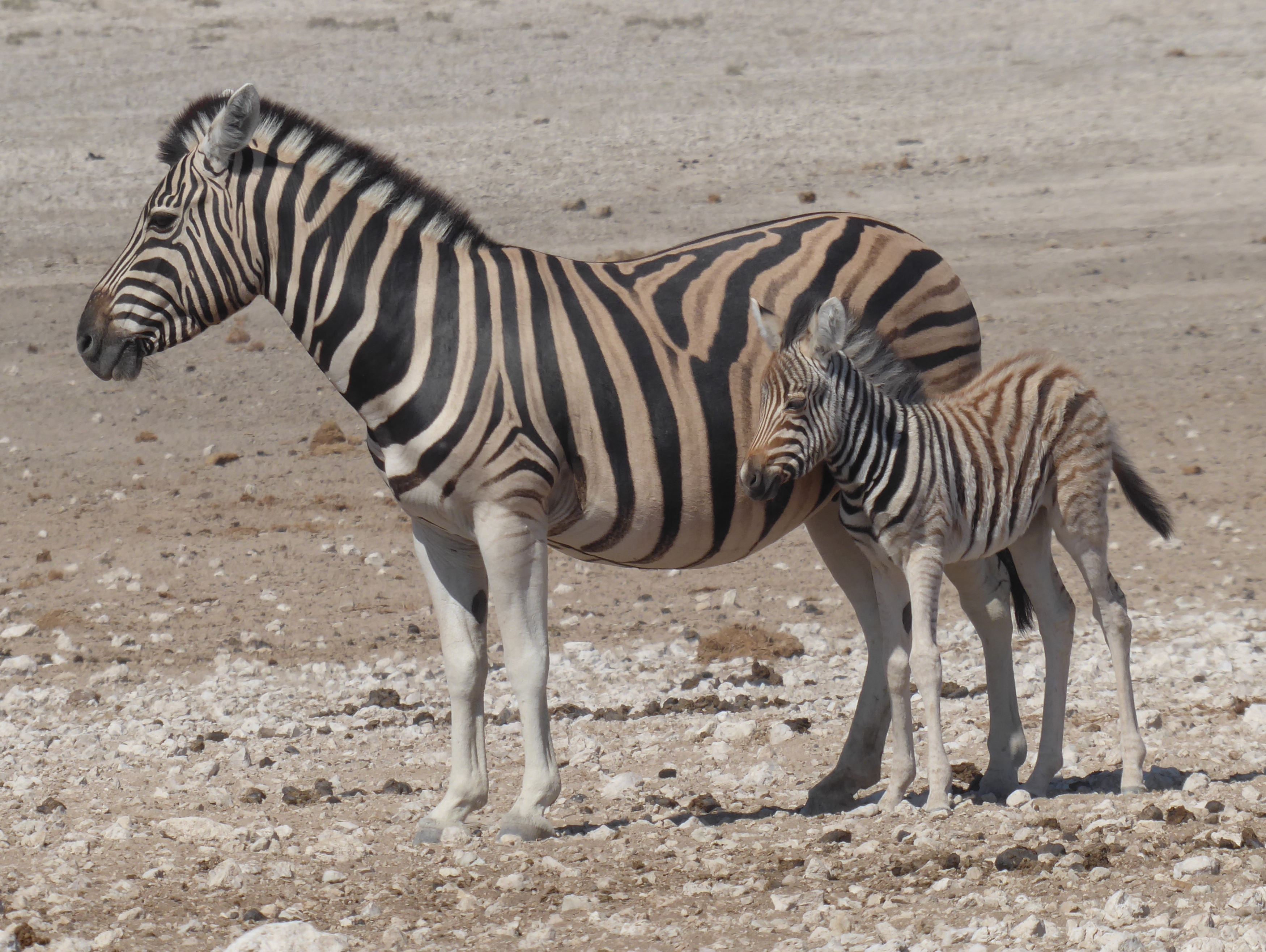
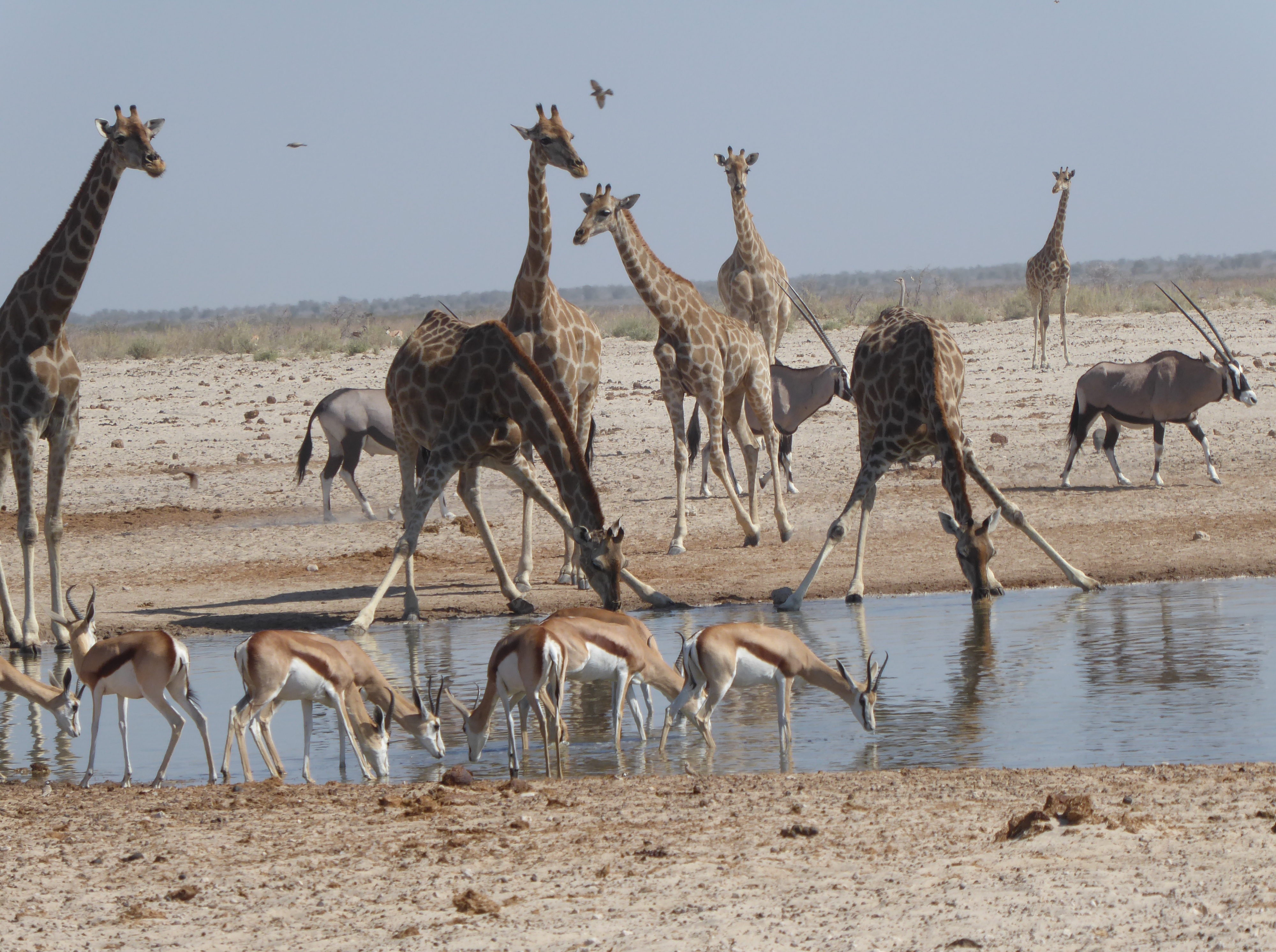
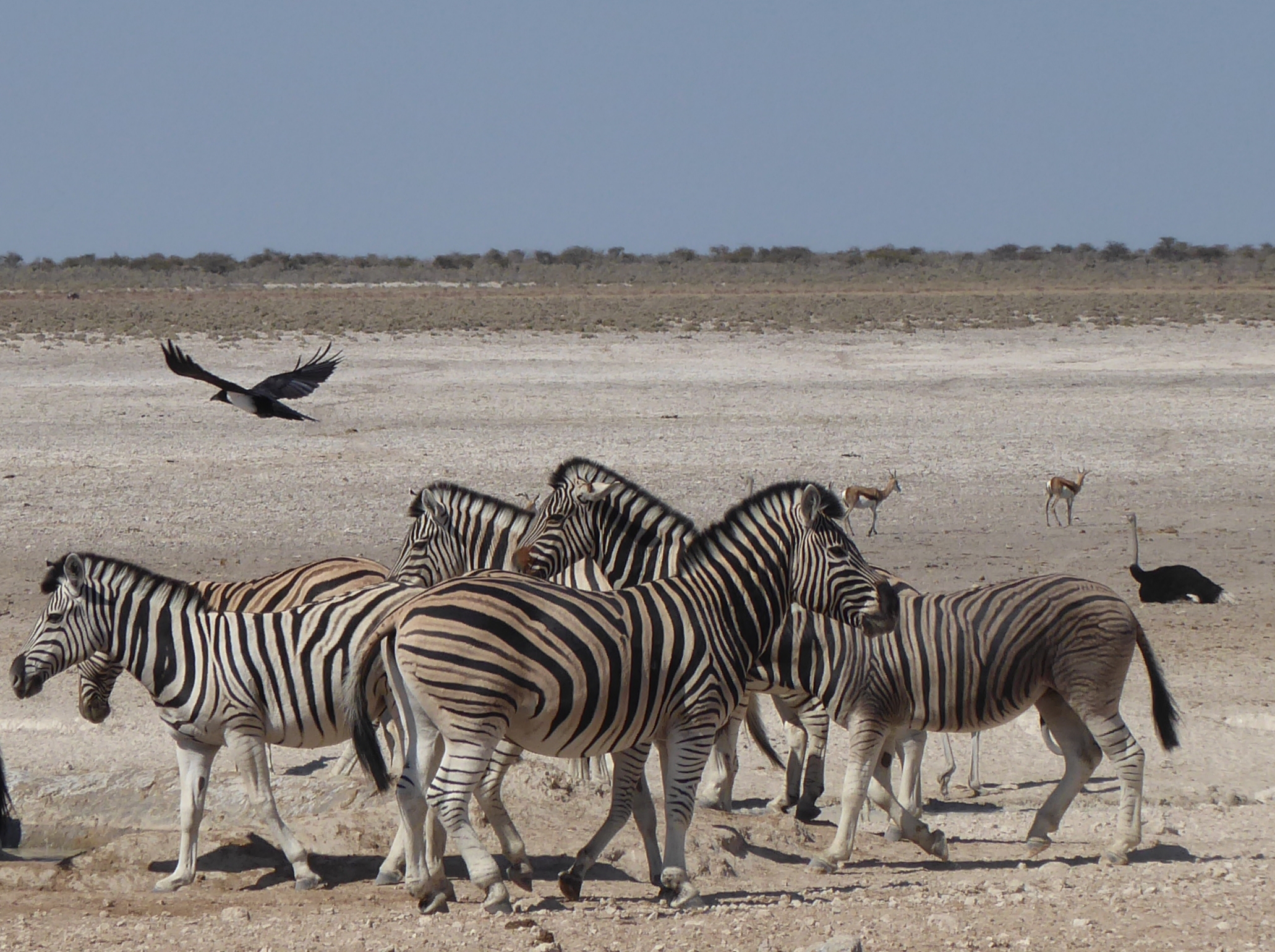
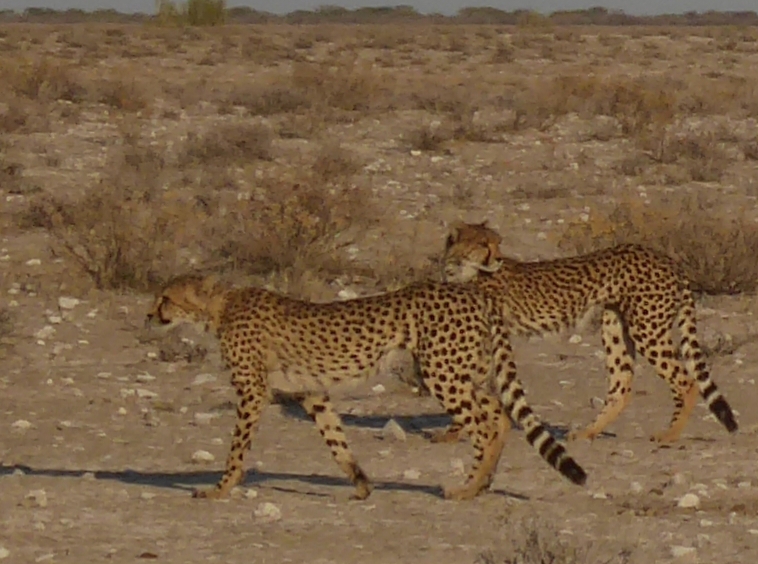
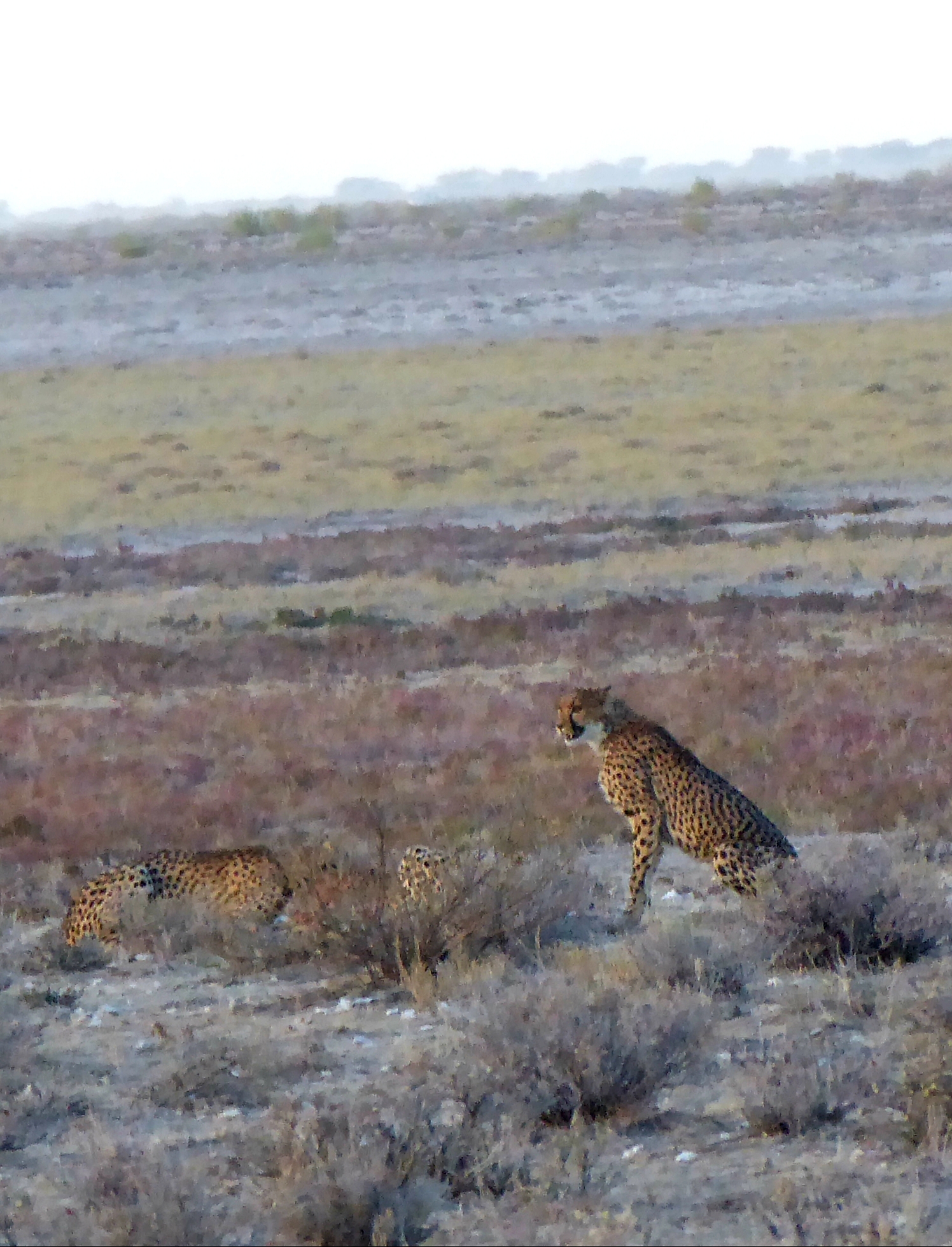
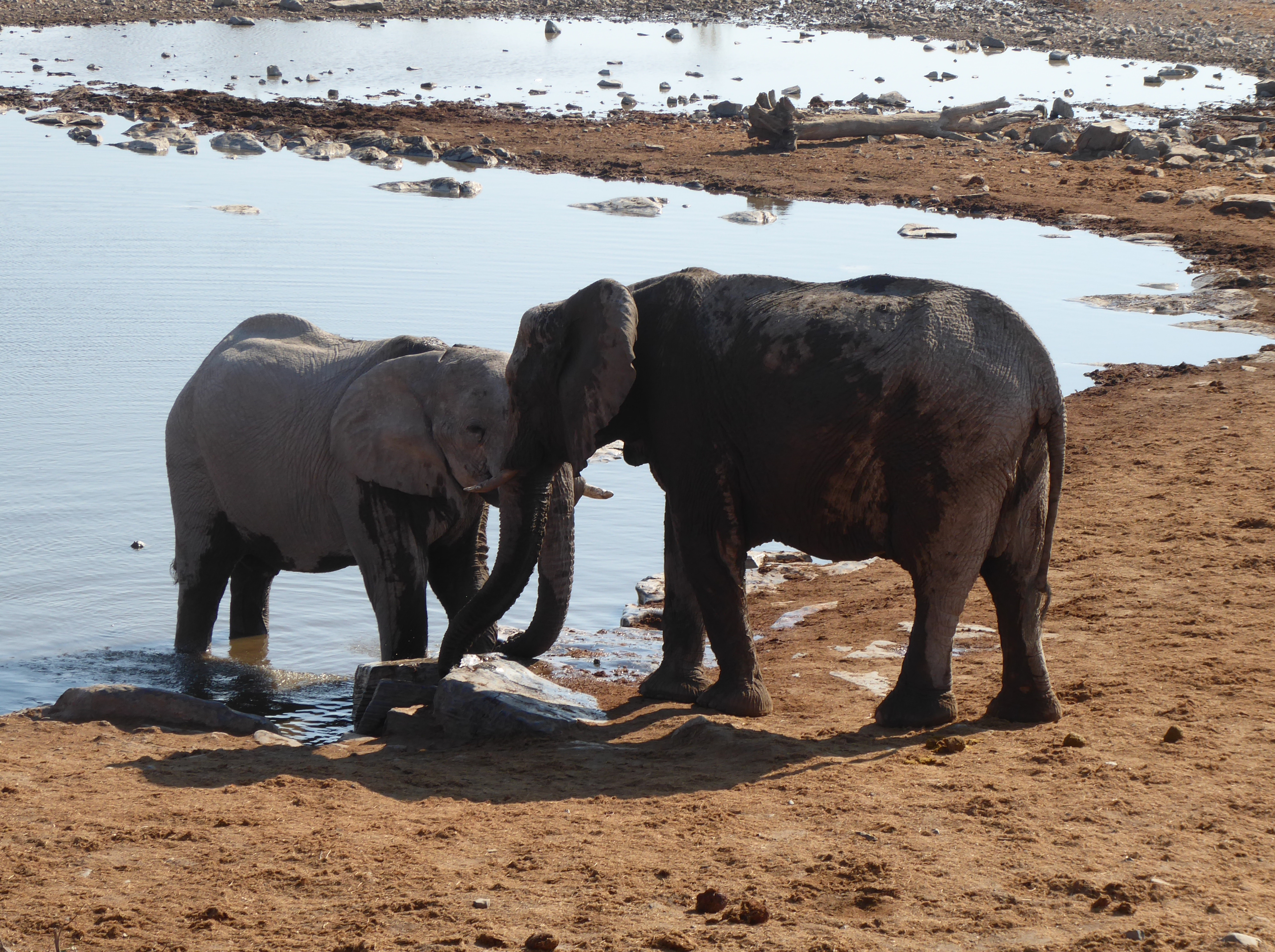
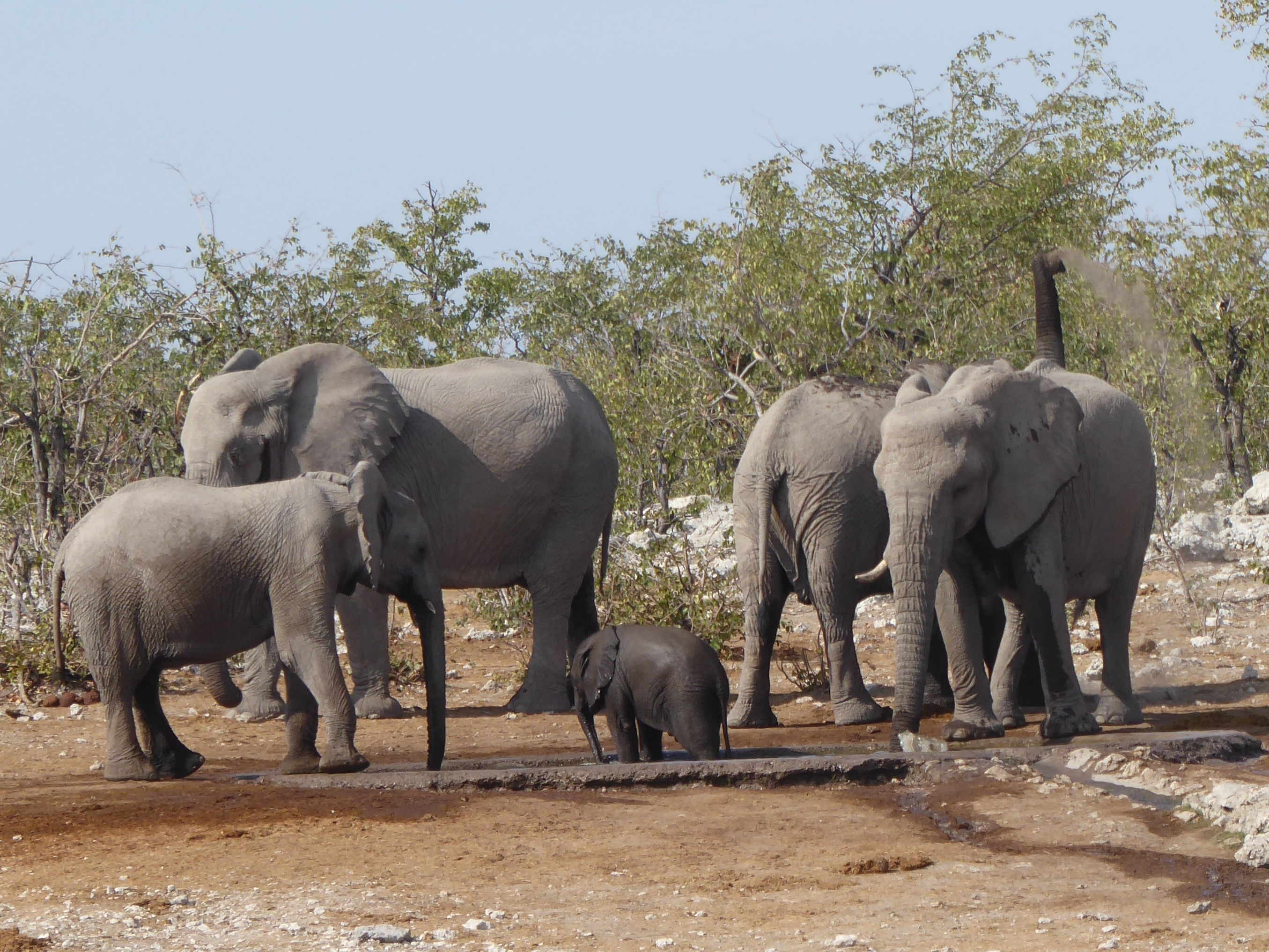
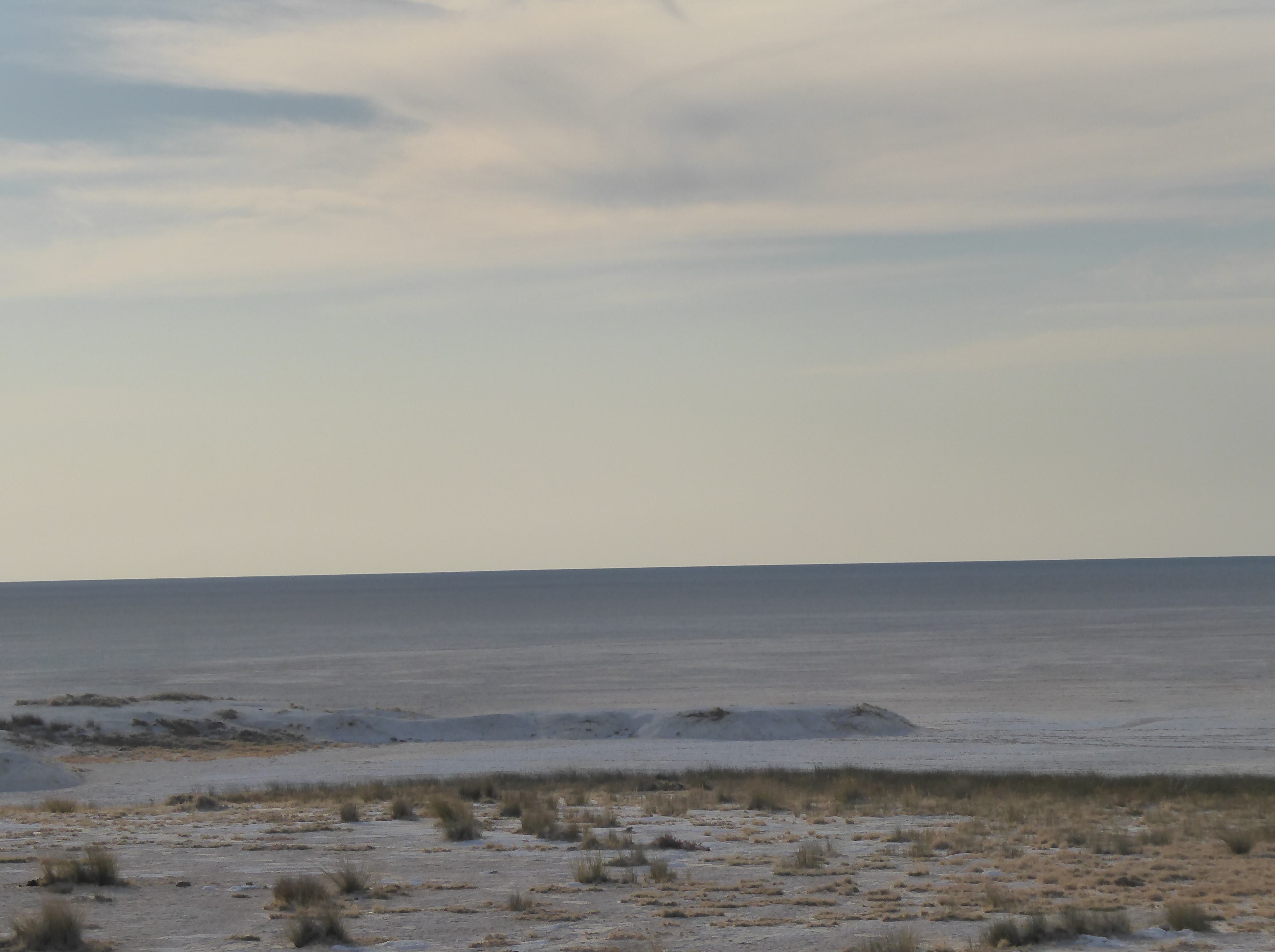
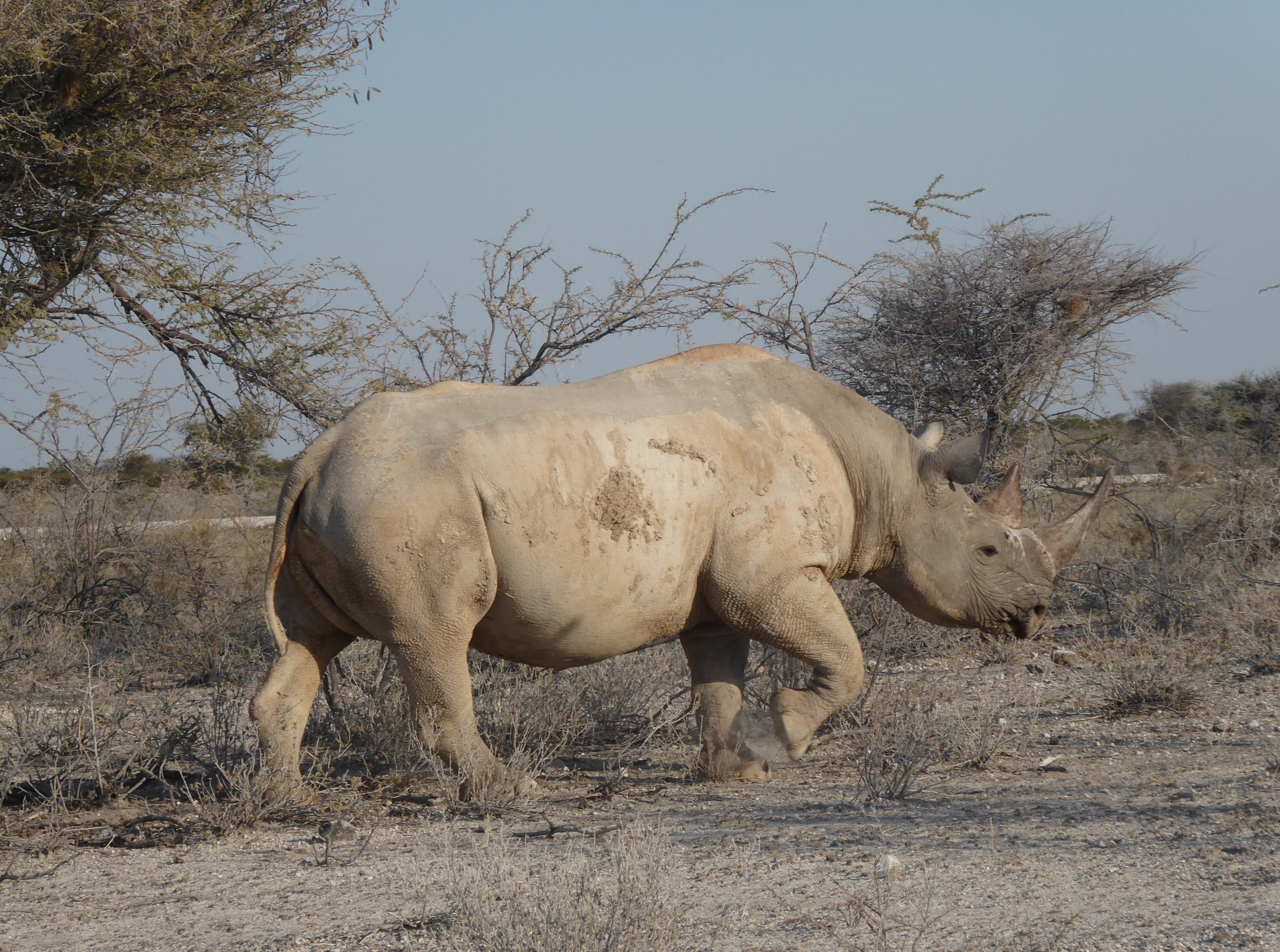
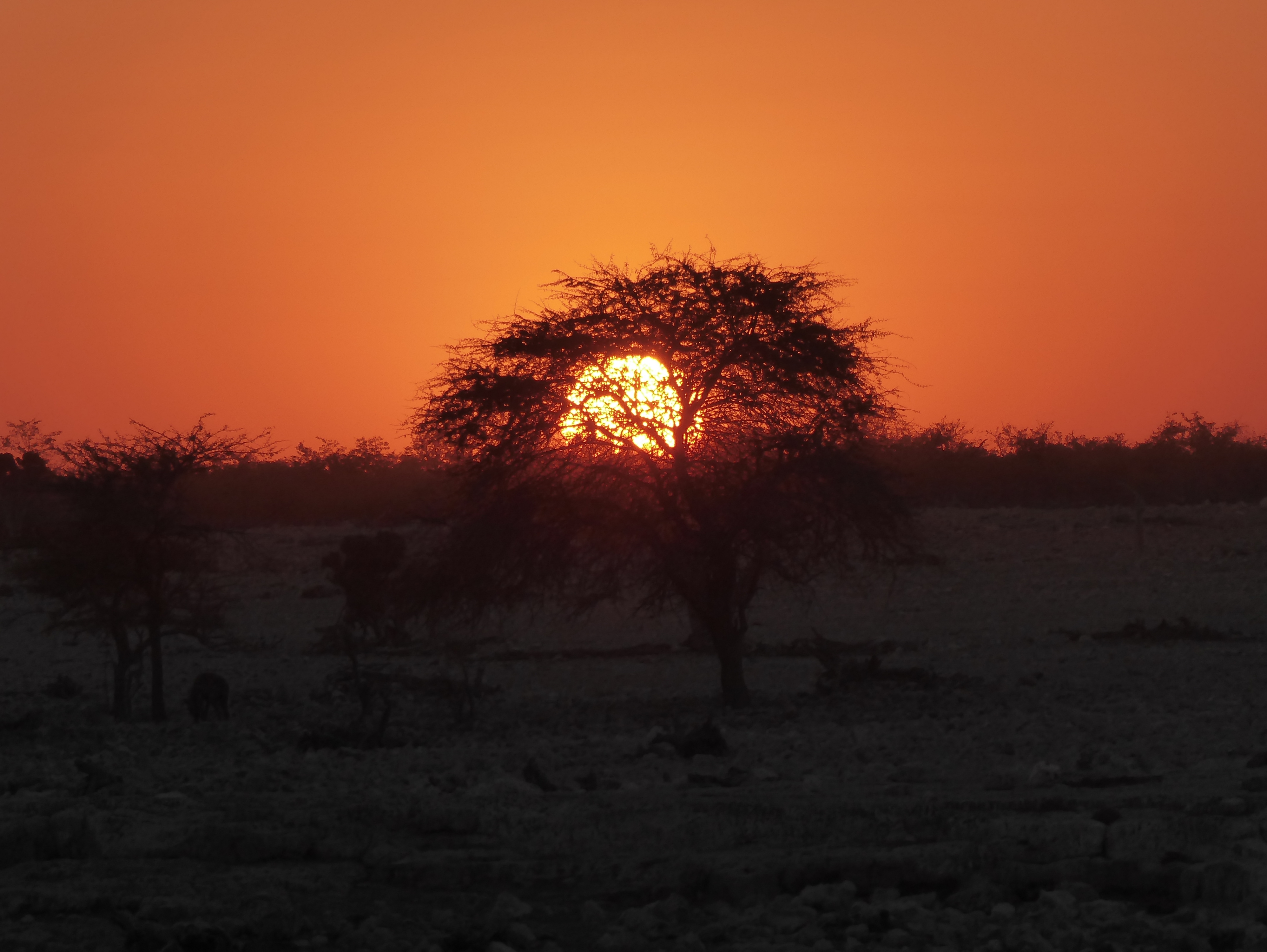


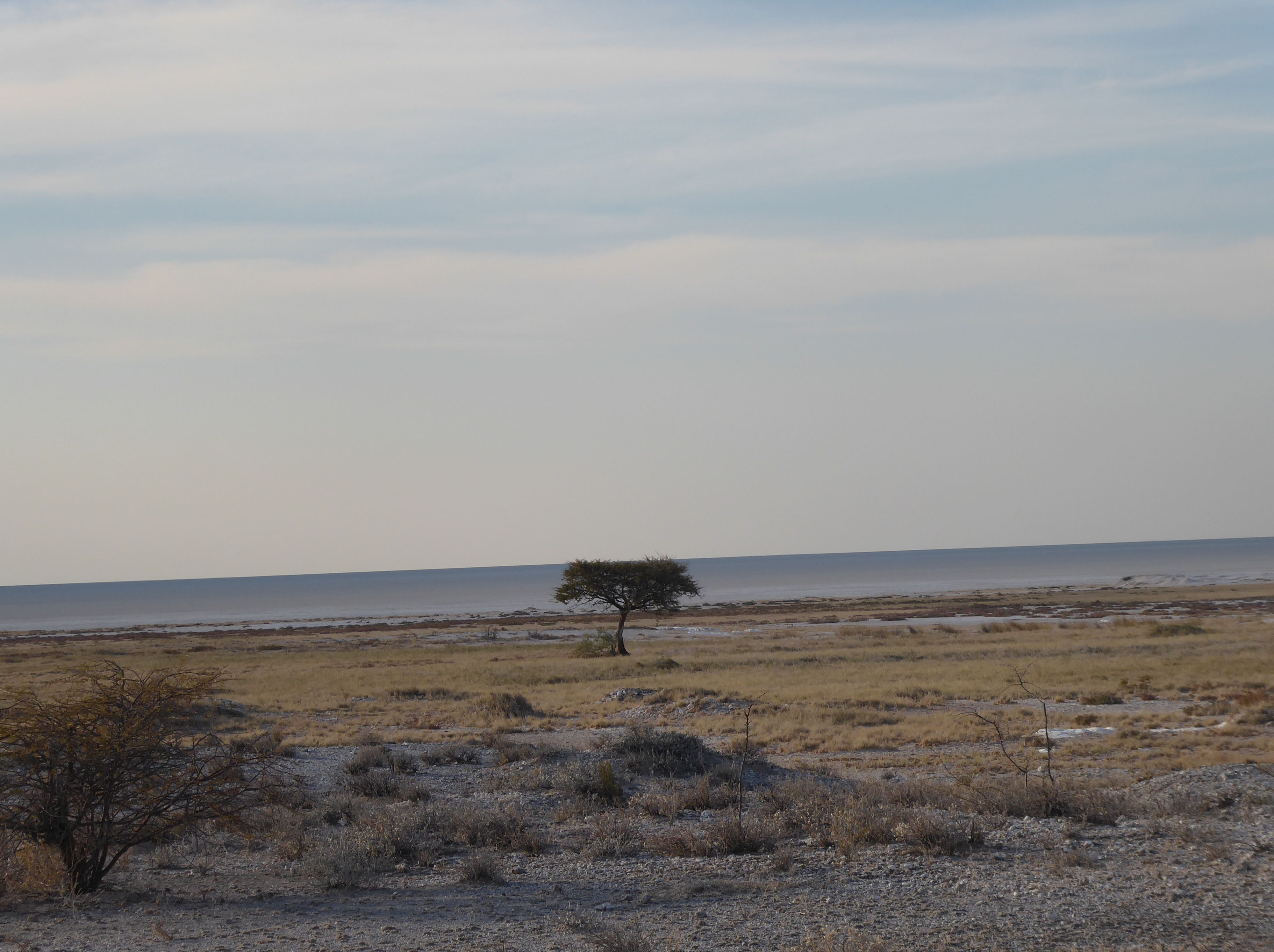
VI. On the Road: Week Five (Etosha National Park to Windhoek )
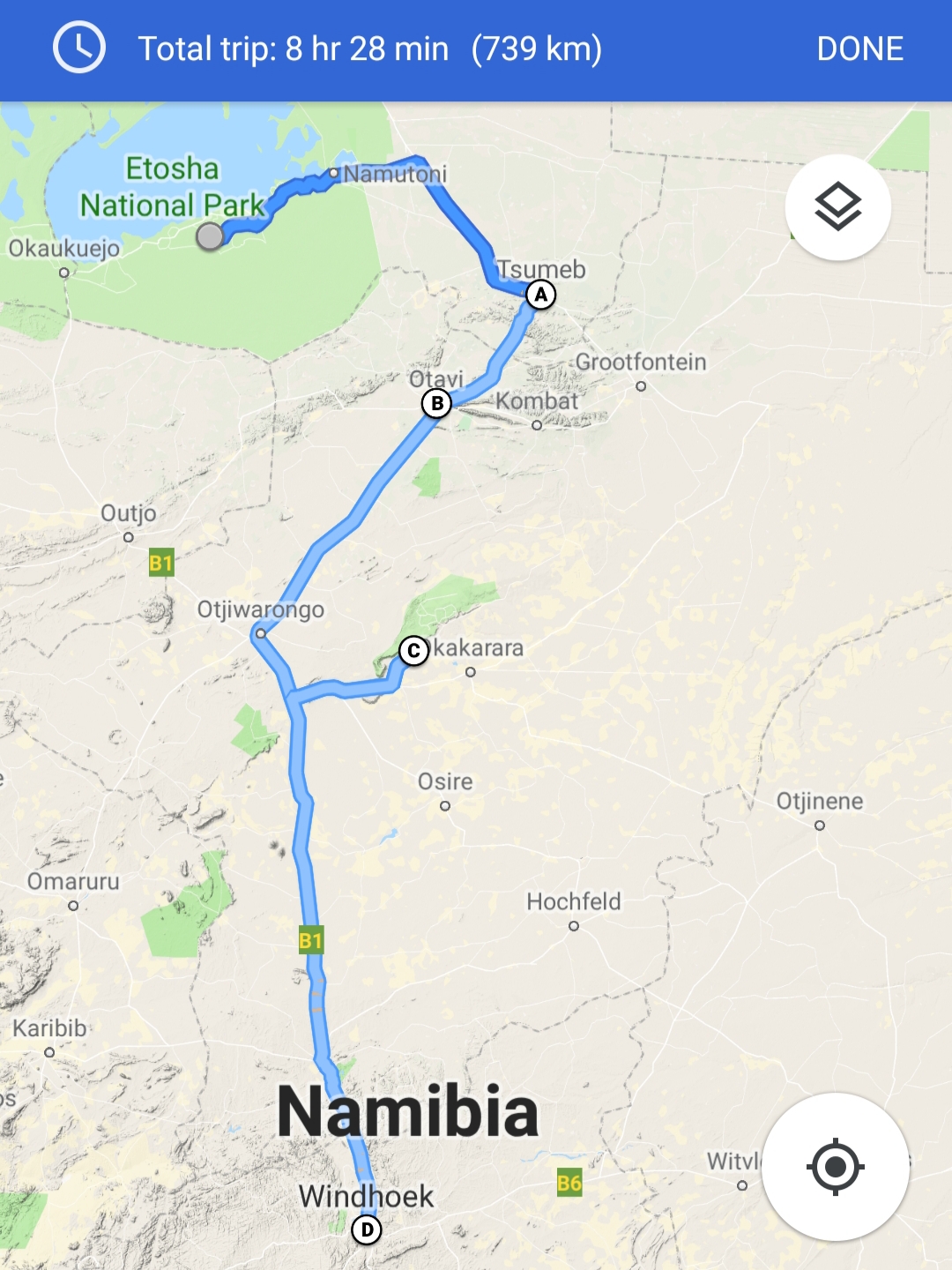 Etosha (Halali), Waterberg, Windhoek
Etosha (Halali), Waterberg, Windhoek
Etosha rewarded me with quintessential images of Africa and indelible memories. Having to leave the park was not easy, but my visa was expiring in a few days. I drove south to Waterberg for my final stop, before a return to Windhoek.
Waterberg offered a diverse landscape, hiking trails, another flat tire, and a too close encounter with a bold, large male baboon.
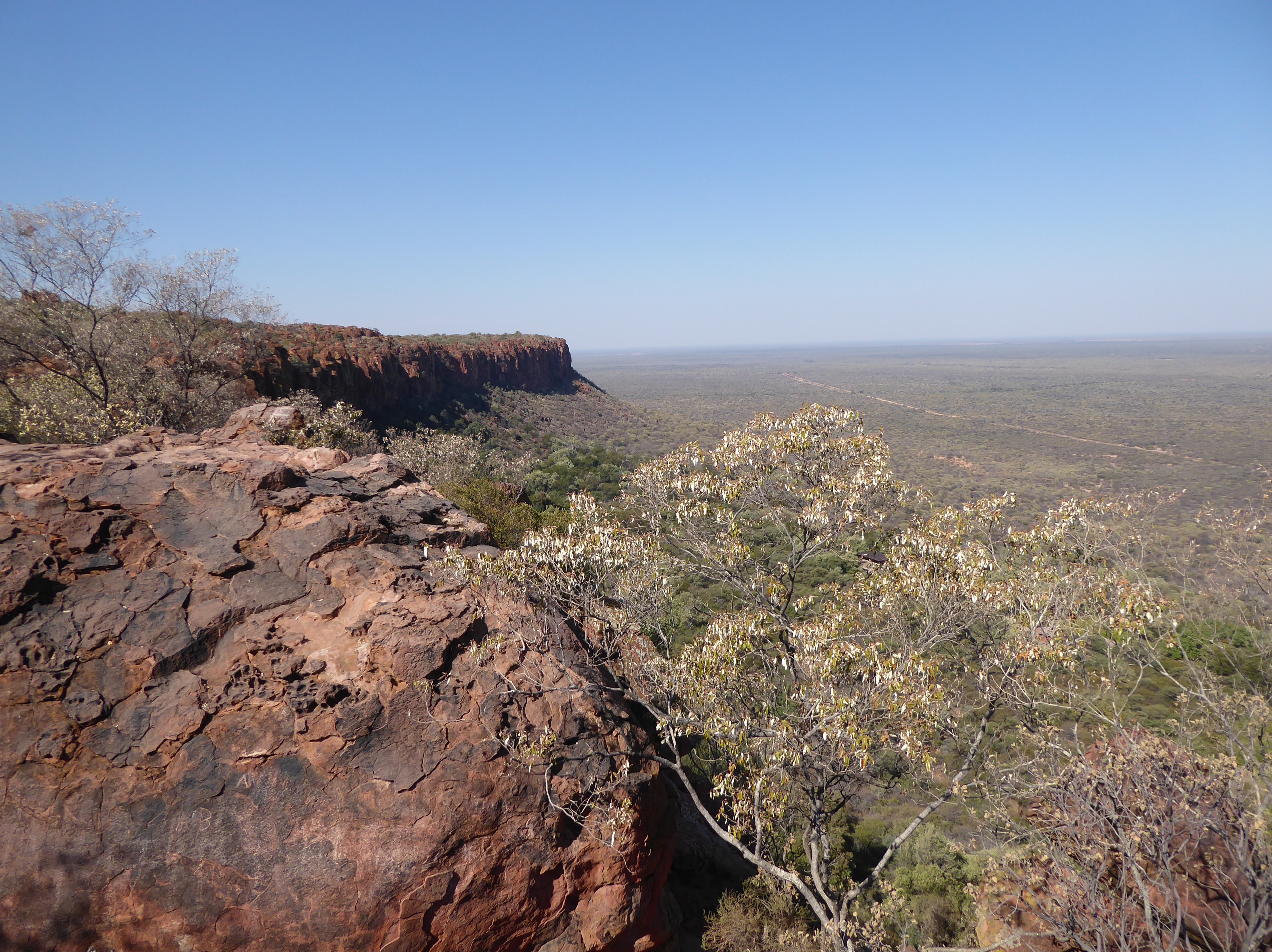
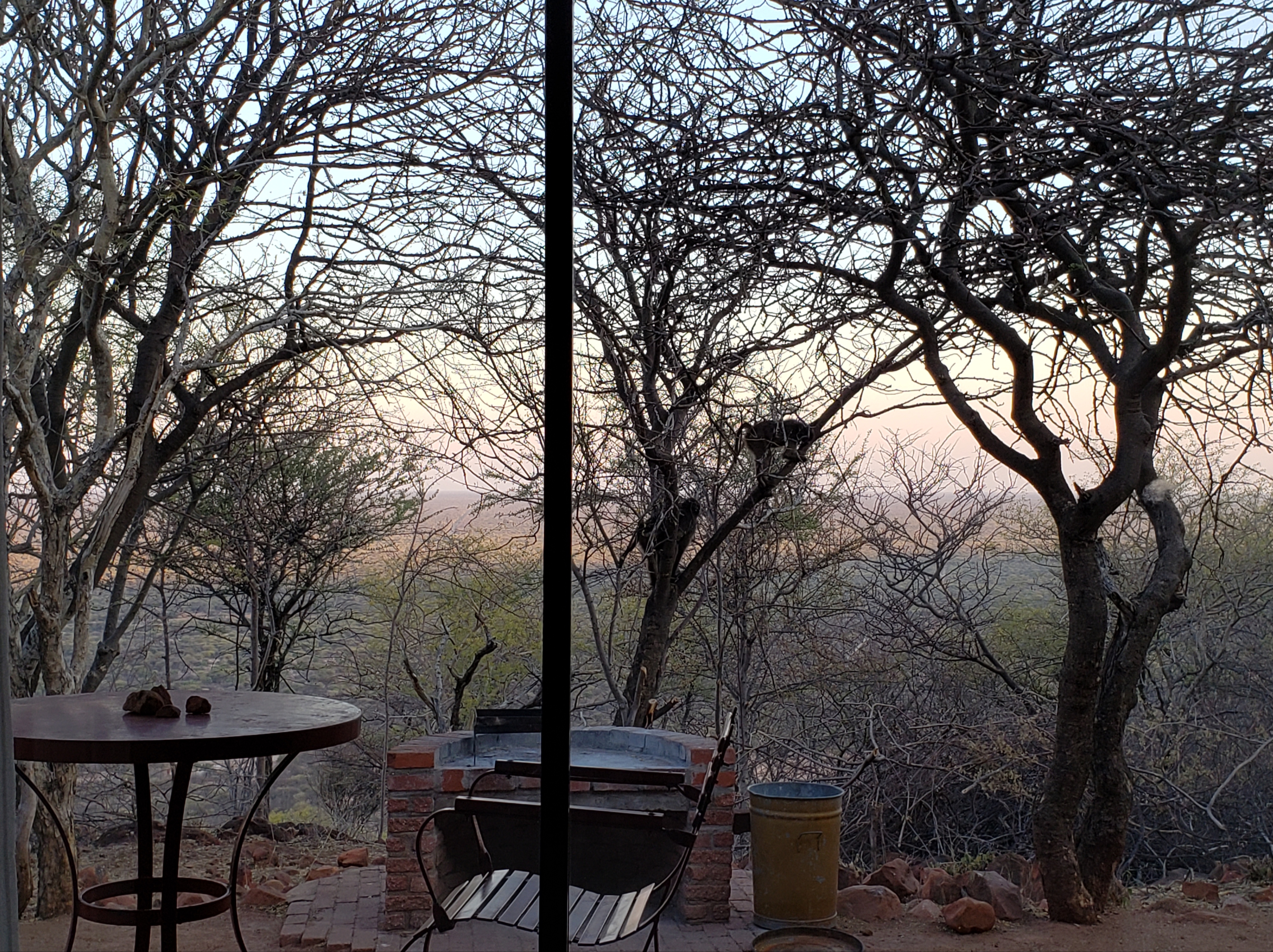
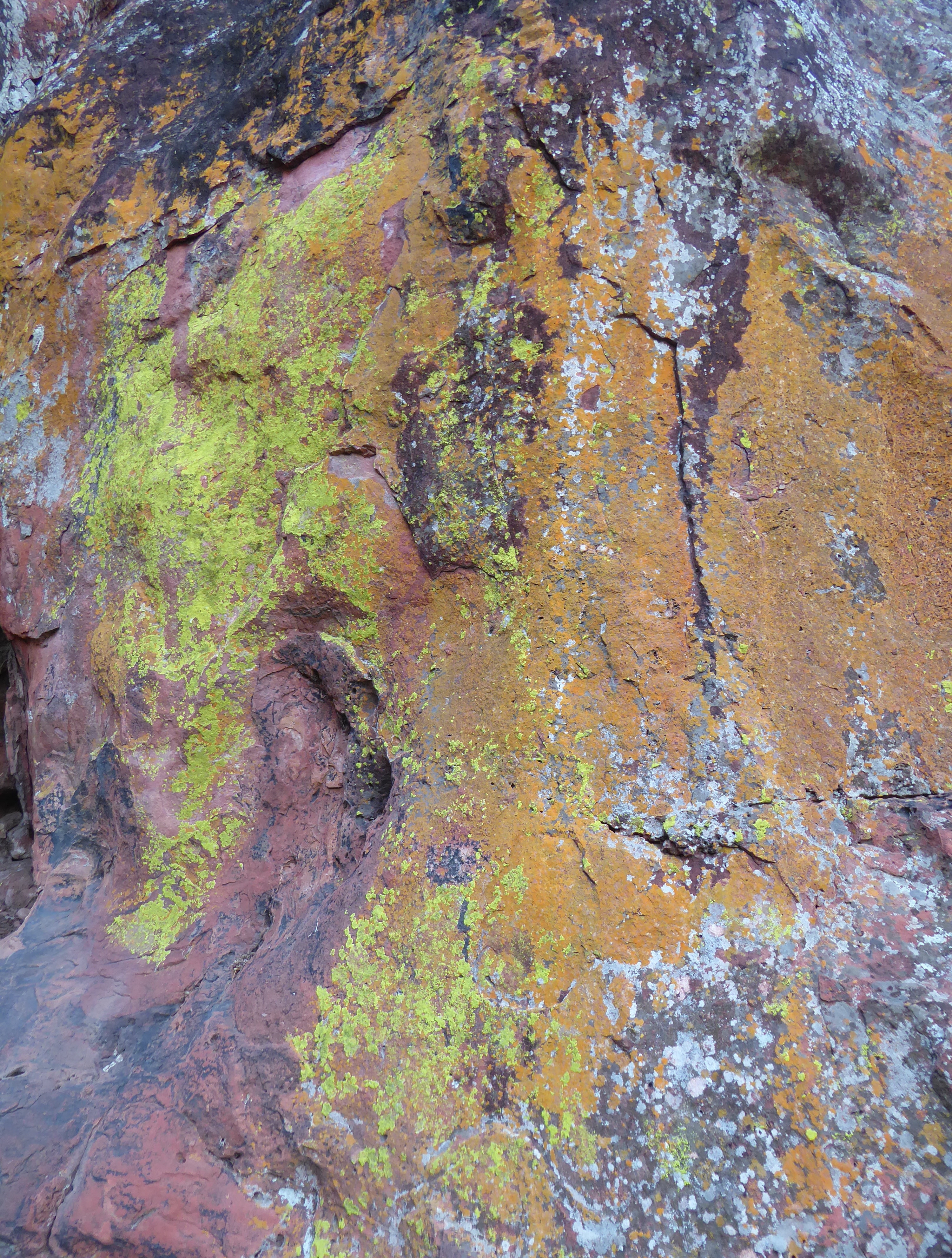
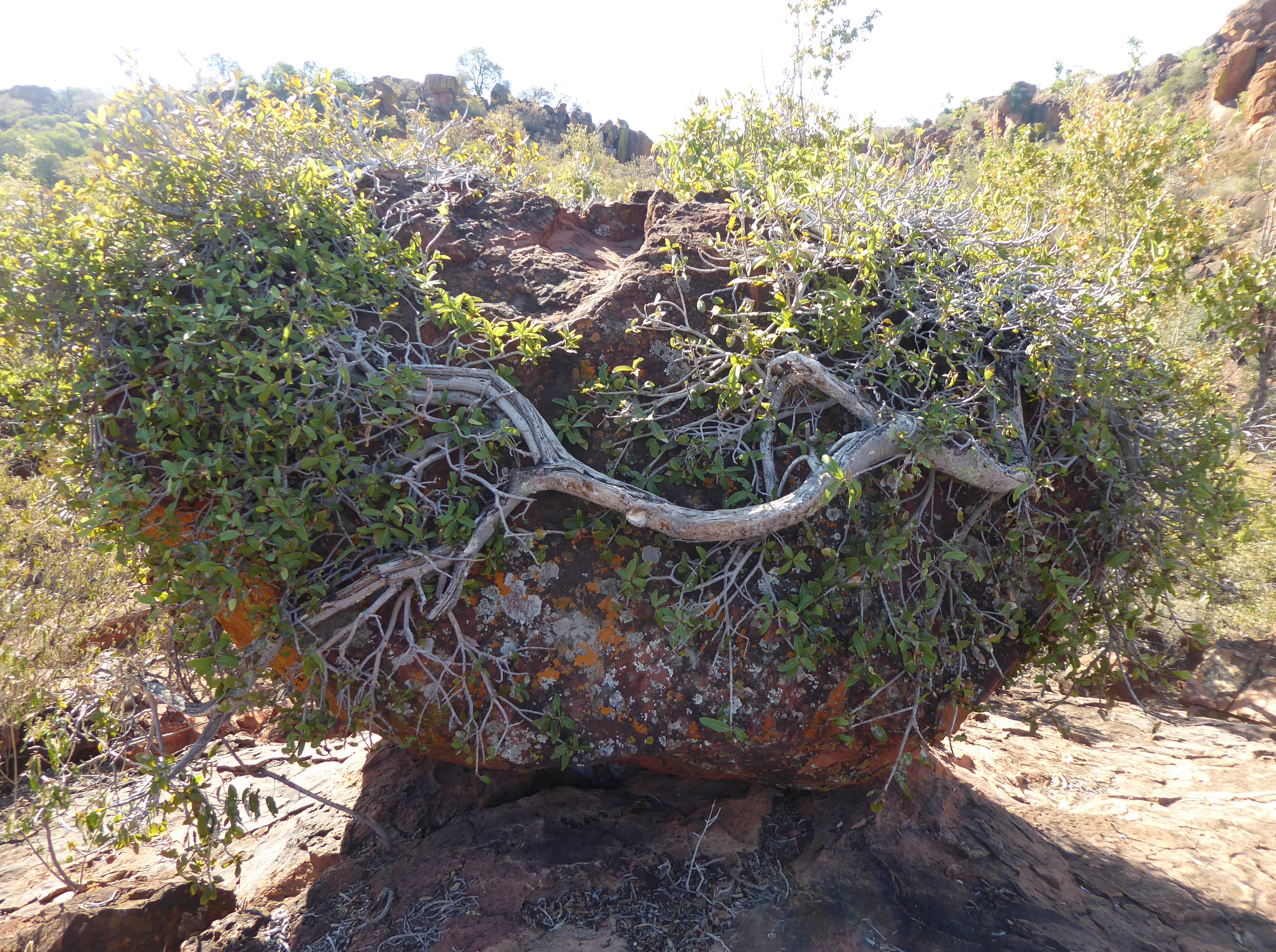
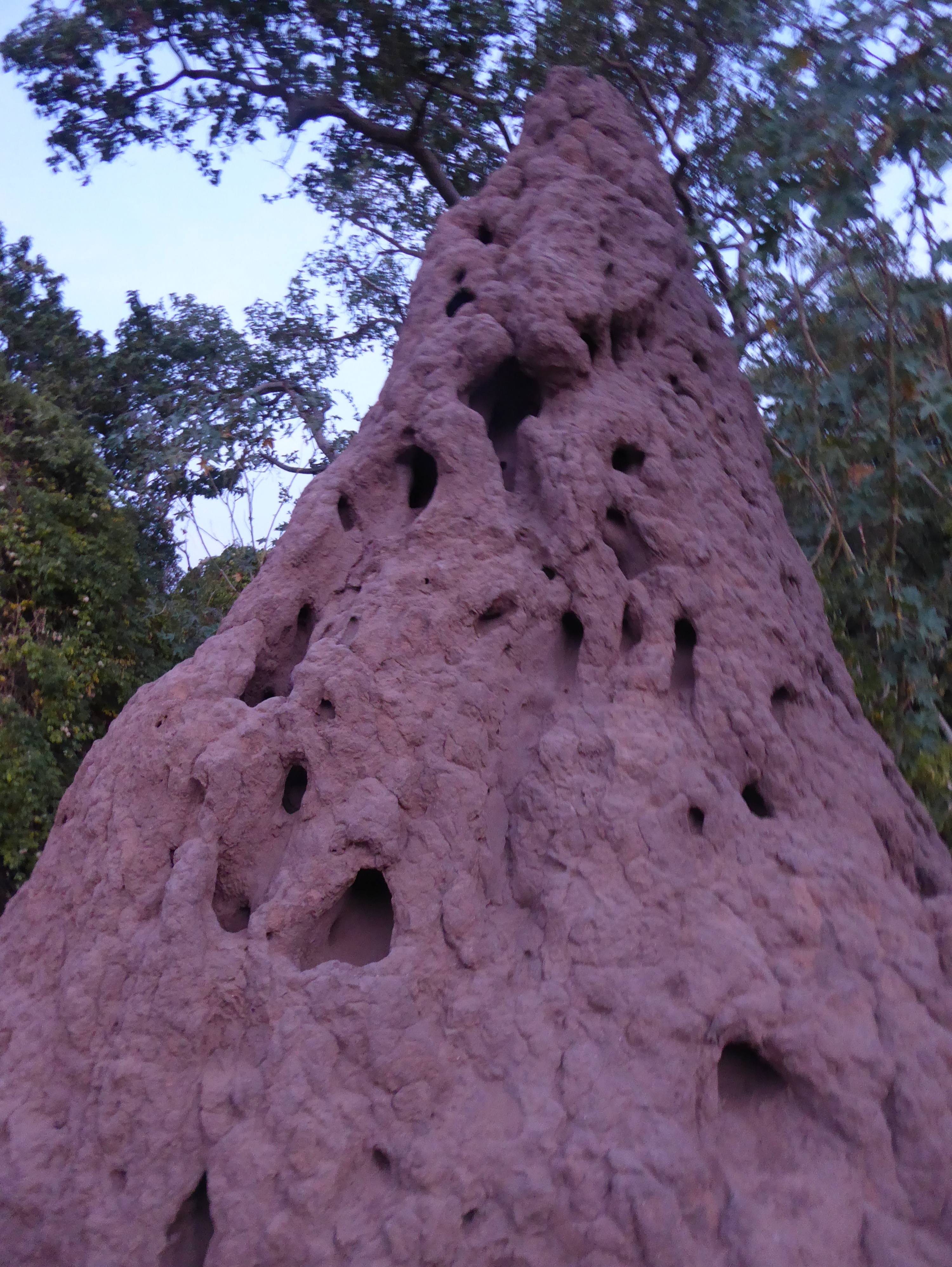
******
Although Windhoek did not win my heart, I didn’t wish to take the chance of having another flat tire and potentially missing my flight. I left Waterberg and booked a room in a home for the night before my departure.
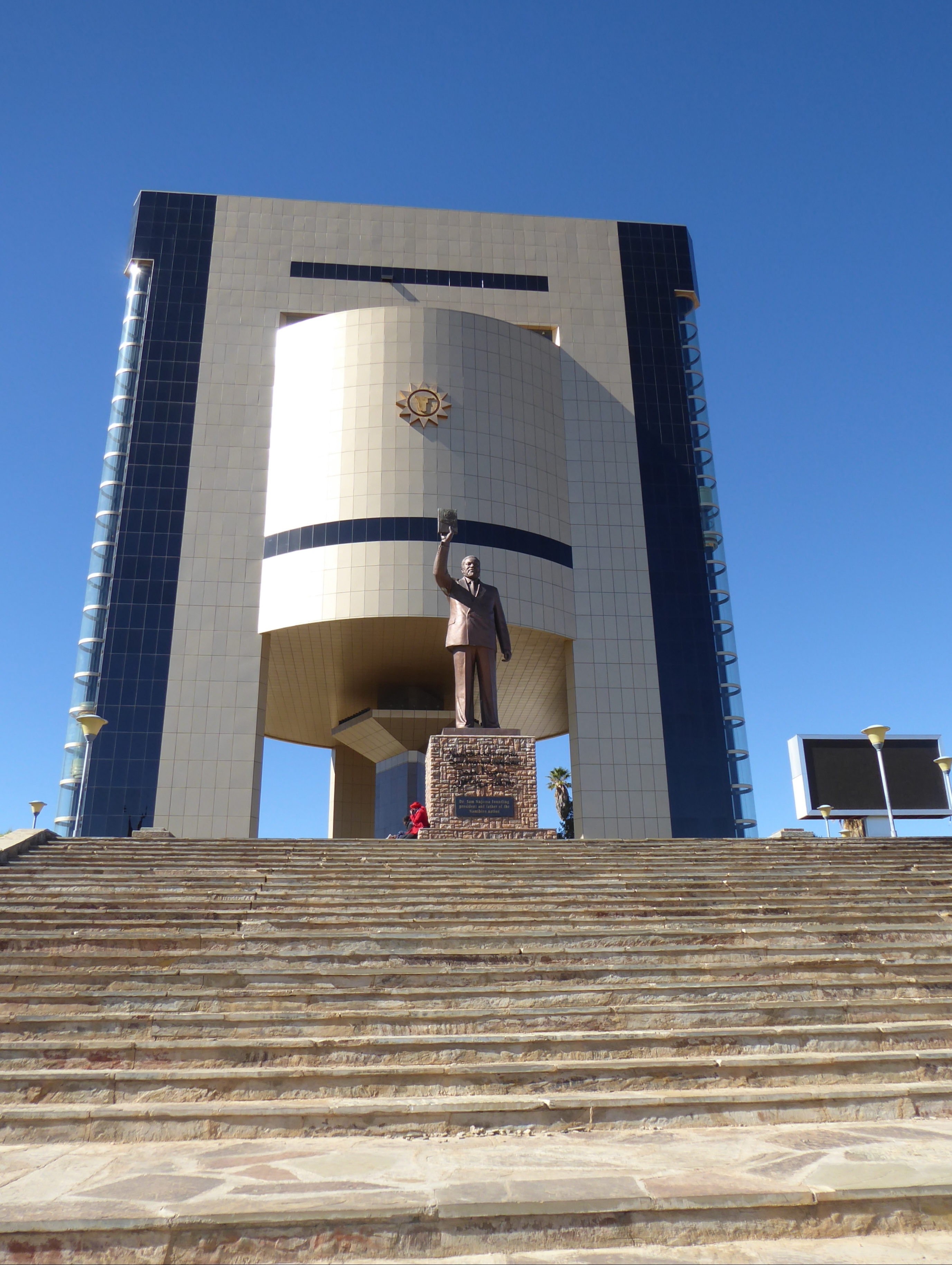
Between Waterberg and Windhoek the minutes on my SIM card had run out leaving me without GPS nor a means to make any calls. The only map I had did not mark all the streets. I finally found my home for the night, but it took a number of precarious wrong turns to get there.
The home with a cavernous living area, staircases that went off in several directions, and nearly vacant, was enormous. The husband was temporarily living in another country for work and the daughter, a finalist for Miss Namibia, was busy with the pageant. The wife/mother was kind, but not particularly social.
Not wishing to get lost the following day en route to the airport, reluctantly, on my last night in the country, I headed to the shopping mall to attend to the SIM card. Leaving my car behind, my host gave me a ride to the mall.
After sorting the card out, I didn’t have the energy to seek out a restaurant or some event in town. In the mall, I saw an eatery that offered an open view of the sky. Watching its colors, as day became night, was a welcome prospect.
My waitress, Sylvia, as I settled in for something to eat and catch up on my writing, continuously touched me with her kindness and sincere caring. I’d been hoping to give my tent away before leaving Namibia, and spontaneously asked if she, or someone she knew, might need one. Tears instantly welled up in her eyes.
Her sister was getting married back in their village and she and many of the guests would be sleeping outdoors. Sylvia was saving up to buy a tent, but hadn’t yet succeeded. She couldn’t believe her good fortune and thanked me again and again. We made arrangements for a driver she knew to take me home and pick-up the tent.
Since then, I’ve been receiving photos of Sylvia’s family in traditional Hereo attire at the wedding, an open-ended invitation to her village, and a request for my shoe size when I complimented her on the slippers she was wearing in one of the photos. “I will send them to you.” she offered.
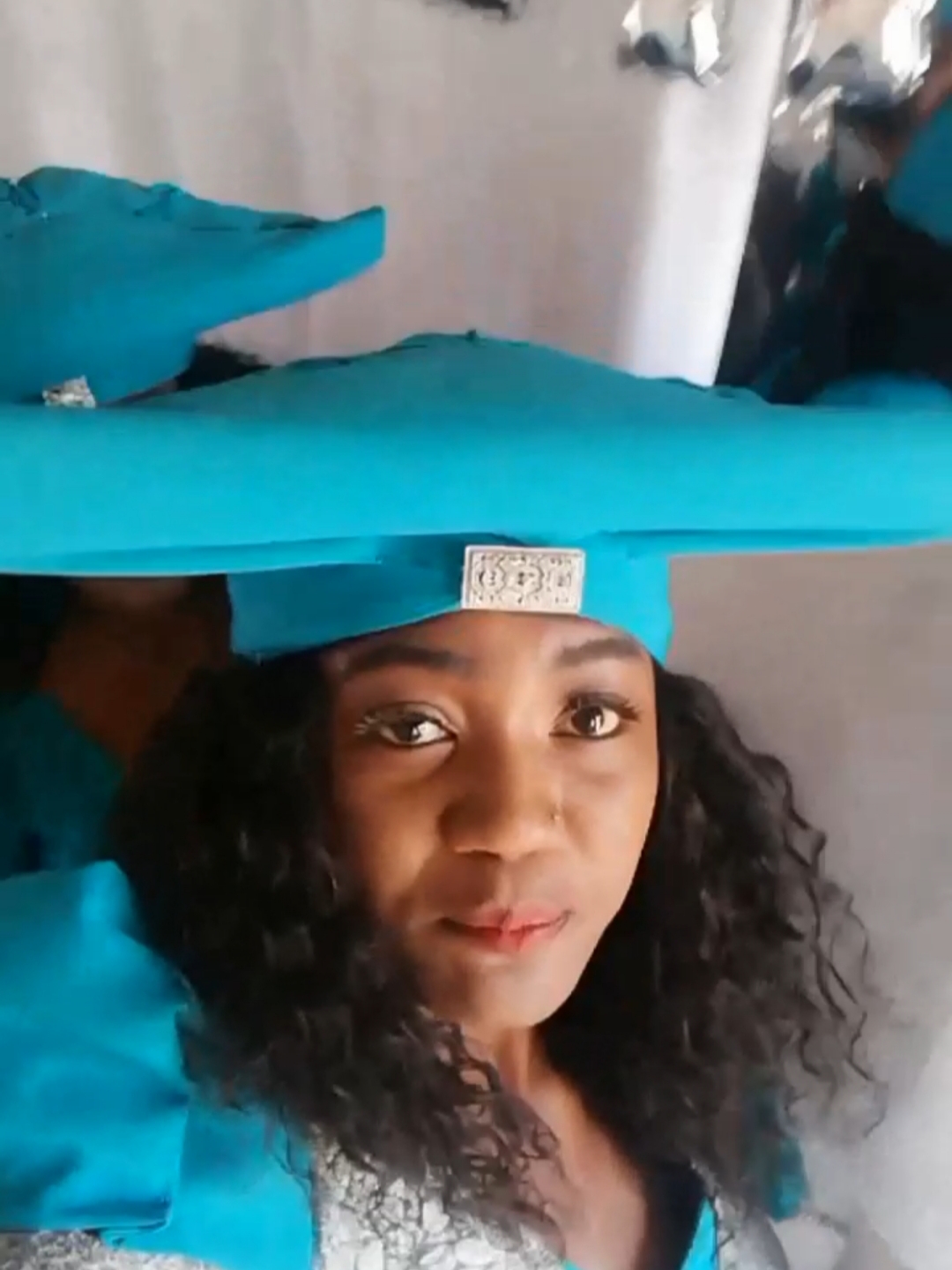
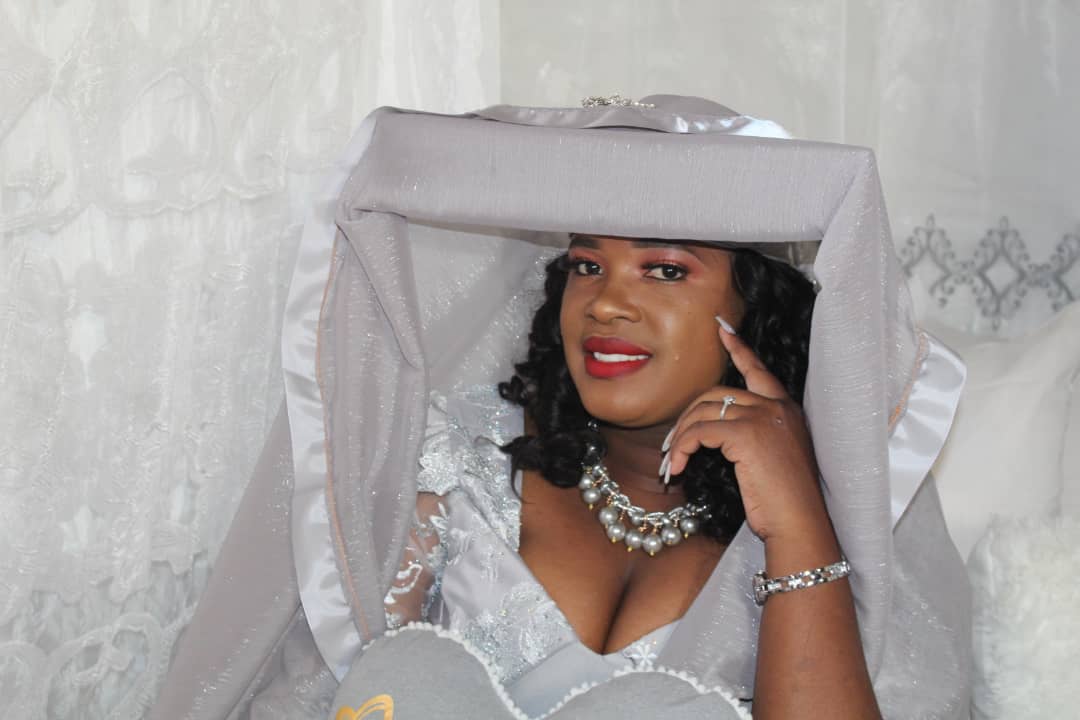
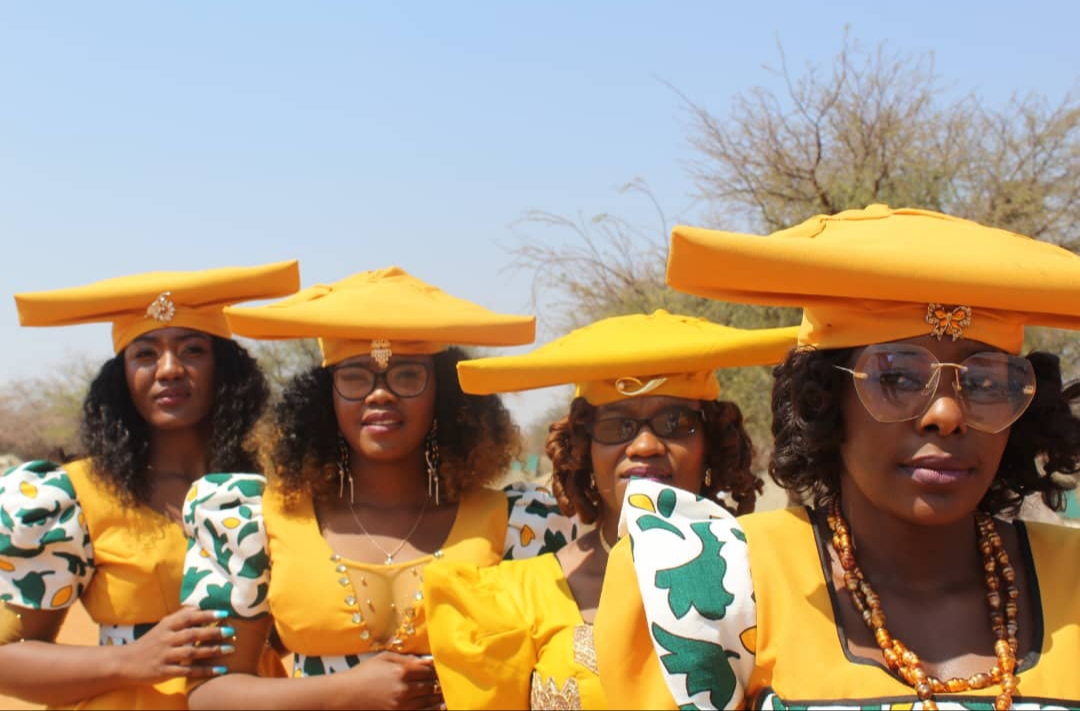
I left Namibia sooner than I would have liked, but there was time enough to forge new friendships, have wonderful encounters, and share memorable moments with good, kind people whose names I never learned: people who offered traveling tips, helped me change my three flat tires, filled my tank with gas while sharing aspects of their lives and asking about my own, gave me directions, took the time to tell a tale, and offered a wave and smile as I drove by.
I hold on tight to the many images of Namibia’s people, wildlife, and terrain knowing in time memories fade.
